
Super Continent: The Logic of Eurasian Integration
by
Kent E. Calder
Published 28 Apr 2019
This network has fostered not only passenger and truck traffic but considerable intermodal transport as well. China has also put considerable effort over the past decade into improving intermodal connections—an effort strongly synergistic with its massive domestic infrastructure program. Under a November 2015 agreement between President Xi and Singapore prime minister Lee Hsien Loong, China and Singapore have been pursuing the Chongqing Connectivity Initiative, building an IoT industrial base in Chongqing that has a strong intermodal logistics dimension, inspired by BRI.52 China is also working on IoT projects oriented to improving BRI logistics with French affiliates of Foxconn, the world’s largest contract manufacturer, and Microsoft of the United States.
…
Outside China, governments in Korea, Singapore, the Netherlands, and the UAE, among others, took parallel steps to facilitate container trade. The increase in maritime trade through container ports proved to be synergistic with intermodal trade also involving road and rail. Revolutionary cost reductions in intermodal transport, intensified by computerization and the Internet of Things, thus exposed inland as well as port cities to transcontinental commerce and simultaneously facilitated transcontinental supply chains.31 A concrete example of this trans-Eurasian intermodal dynamic in operation is the production, distribution, and marketing of personal computers and their components between China and central-southern Europe.
…
This transformation greatly simplifies, speeds up, and cheapens the cost of intermodal travel, thereby magnifying synergistically the impact of other geo-economic factors. The Logistics Revolution has uniquely powerful implications for Eurasia, for at least four reasons. First, land routes between major European and Chinese manufacturing centers, for which logistical connections have heretofore been chronically underdeveloped, are much shorter than sea routes. Second, Eurasian transport involves an unusual variety of intermodal transfers, leading to a distinctively sharp decline in transport costs due to recent technological change.
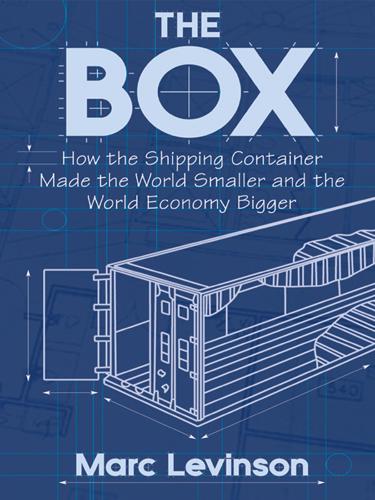
The Box: How the Shipping Container Made the World Smaller and the World Economy Bigger
by
Marc Levinson
Published 1 Jan 2006
Ibid., Powell testimony November 1, 1967, pp. 70–71; Harlander interview, COHP. 36. Minutes, combined meeting of MH-5 Load and Testing and Handling and Securing Subcommittees, November 30, 1966; Leslie A. Harlander, “Intermodal Compatibility Requires Flexibility of Standards,” Container News, January 1970, p. 20; Minutes of MH-5 committee, January 29 and May 20–21, 1970; L. A. Harlander, “Container System Design Developments,” p. 368. 37. Marad, “Intermodal Container Services Offered by U.S. Flag Operators,” January 1973 (unpaginated). Chapter 8 Takeoff 1. New York figure estimated from PNYA data; West Coast figure taken from Hartman, Collective Bargaining, p. 160. 2.
…
“Coast Carriers Win Rate Ruling,” NYT, January 5, 1961; Robert W. Harbeson, “Recent Trends in the Regulation of Intermodal Rate Competition in Transportation,” Land Economics 42, no. 3 (1966). The case was finally decided in the railroads’ favor by a unanimous Supreme Court, ICC v. New York, New Haven & Hartford, 372 U.S. 744, April 22, 1963. The dubious economics of determining a railroad’s “fully-distributed cost” of carrying a particular load are, fortunately, beyond the scope of this book. 16. Holcomb, “History, Description and Economic Analysis,” p. 220; Bernard J. McCarney, “Oligopoly Theory and Intermodal Transport Price Competition: Some Empirical Findings,” Land Economics 46, no. 4 (1970): 476. 17.
…
Strauss, Jr., The Burlington Northern: An Operational Chronology, 1970–1995, chap. 6, available online at www.fobnr.org/bnstore/ch6.htm; Kuby and Reid, “Technological Change,” p. 282. Paul Stephen Dempsey, “The Law of Intermodal Transportation: What It Was, What It Is, What It Should Be,” Transportation Law Journal 27, no. 3 (2000), looks at the history of regulations governing intermodal freight. 40. Robert C. Waters, “The Military Sealift Command versus the U.S. Flag Liner Operators,” Transportation Journal 28, no. 4 (1989): 30–31. 41. Lloyd’s Shipping Economist, various issues; Hans J. Peters, “The Commercial Aspects of Freight Transport: Ocean Transport: Freight Rates and Tariffs,” World Bank Infrastructure Notes, January 1991; author’s interview with William Hubbard.

Arriving Today: From Factory to Front Door -- Why Everything Has Changed About How and What We Buy
by
Christopher Mims
Published 13 Sep 2021
(This is one reason shipping container architecture, far from being some kind of Earth-friendly “recycling,” is in many cases an absurd vanity: stripping away all that nasty stuff takes more time, money, and energy than building a comparable structure anew.) Shipping containers are what are known as “intermodal” transports, which means they can be carried by two or more means of transport. Intermodality and containerization are quite old. It’s a bit obscure at what point the plain old box became an intermodal “container,” but as early as the late eighteenth century, wooden boxes of coal were being transported by barge in England, then transferred to horse-drawn wagons. The shipping container holding our box of boxes, containing our small army of USB chargers, rides on a chassis pulled by a semitruck.
…
But, as is the case in most ports in the world, the majority of containers that move into and out of the Port of Los Angeles are carried on the backs of trucks. However they will ultimately leave the port, most containers are carried into the container yard, the place where they idle between being taken off a ship and being put on some sort of intermodal transport, like a train or truck. (The Port of Hamburg is exploring using a Hyperloop, the ultrafast transport system proposed by Elon Musk, as a form of intermodal transport, but such a system would be hugely expensive and take decades to complete.) Not far from where the autostrads picked up their containers, they place them on the concrete a second time. Here, they’re picked up by a different sort of gantry crane, known as an automated stacking crane.
…
In a port, the solution to this problem is those big, lumbering automated stacking cranes building city-block-long, apartment-building-size stacks of shipping containers. Those endless rows of steel boxes are, if you think about it, a buffer between container ships and the trucks and trains they must hand off their goods to. Intermodality at this scale wouldn’t work otherwise. Having a big buffer of containers allows the quayside cranes—the scarcest resource in any port—to operate flat out whenever a ship arrives, pulling containers off as quickly as humanly possible. Then, with inhuman efficiency, the ant-like autostrads rolling around on their octuplet of wheels grab the containers and shuttle them to the automated stacking cranes.
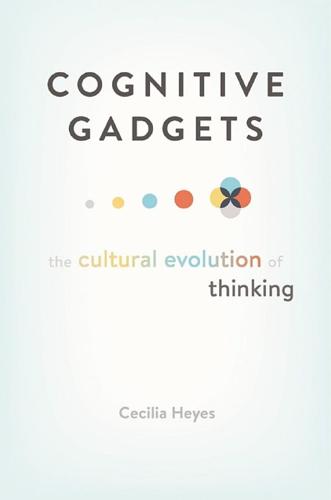
Cognitive Gadgets: The Cultural Evolution of Thinking
by
Cecilia Heyes
Published 15 Apr 2018
Meltzoff and Moore’s “active intermodal matching” model describes the device as “innate equipment,” says that it detects “equivalences between observed and executed acts,” and suggests that the inborn mechanism codes both observed and executed acts “supramodally” as “organ relations”—the configuration of body parts produced by a body movement (Meltzoff and Moore, 1997; Meltzoff, 2002; 2005). However, the active intermodal matching model does not propose computations that would allow organ relations to be derived from observed body movements or to be cashed out as executed actions. So, the active intermodal matching model says there is an inborn thing inside the imitator that solves the correspondence problem, but it doesn’t tell us how the thing works.
…
So, the active intermodal matching model says there is an inborn thing inside the imitator that solves the correspondence problem, but it doesn’t tell us how the thing works. In cognitive neuroscience, not long before Meltzoff and Moore (1997) published their fullest exposition of the active intermodal matching model, Giacoma Rizzolatti and his group in Parma discovered neurons in the premotor cortex of monkeys with some very interesting properties (di Pellegrino, Fadiga, Fogassi, Gallese, and Rizzolatti, 1992). Now known as “mirror neurons” (Gallese, Fadiga, Fogassi, and Rizzolatti, 1996), each of these cells fires not only when a monkey executes a particular action (for example, pinching) but also when the monkey passively observes a similar action performed by another agent.
…
Whenever our discussions have returned to a particular topic in this book, Martin has been able to recall where we last tackled the issue—for example, teleosemantics while walking in Highgate Woods, implicit mindreading outside a café in Genoa, linguistic universals on the way to a friend’s wedding—and by that method to remember virtually everything we said. For this skill, but yet more for the acute insights and warm encouragement he has given in these unforgotten discussions, I am hugely grateful. Index A Active intermodal matching model of imitation, 120 Adaptation: genetic, 36, 65; language, 191, 192; reading and literacy, 20–22; teaching / mindreading, 146 Aggression, 54, 55, 56 Alphabetic systems, 150 Altruistic behavior, 11 Anderson, M.L., 183 Androgen reactivity, 55 Animals: animal-human hierarchies, 7–8; associative learning, 67–70, 71, 105, 135–136; cognitive ability, 48–49, 73–74; cognitive research, 67–68, 72–73, 120–121; convergent evolution, 49, 61; cultural learning, 84–85; executive function, 72–73, 73–74; human attention, compared, 61–62, 65–66; human cognitive mechanisms compared, 52–54; human emotions / motivation, compared, 54–60; nature and nurture, and development, 29, 46, 48–49; response-contingent stimulation, 59; selective social learning, 92–93, 101–102, 103–104, 105; sequence / language learning, 187, 196; social learning, 48, 56, 84–85, 92–93, 95–96.
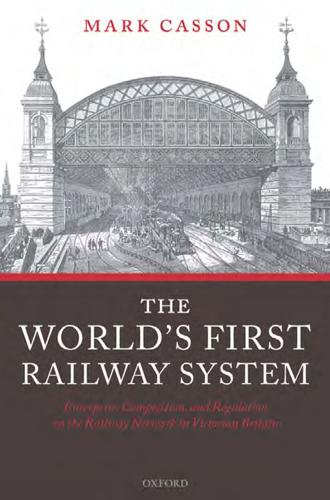
The World's First Railway System: Enterprise, Competition, and Regulation on the Railway Network in Victorian Britain
by
Mark Casson
Published 14 Jul 2009
The railways were part of a steam revolution which was aVecting other industries too—including mining, manufacturing, and shipping. Steam railways could connect steam-powered manufacturing at one end of the line with steam shipping at the other—just as the pioneering Liverpool and Manchester Railway had done. Railways facilitated the formation of a steam-based international intermodal transport system, with inter-modal hubs at major ports. Railways could act as feeders to these ports, or as land-bridges between them. Steam facilitated speed, and speed attracted passenger traYc as well as freight. The potential of speed encouraged the construction of long-distance inter-urban main lines—lines very diVerent from the very Wrst horse-drawn mineral railways.
…
Track and trains forged the connections. The conWguration of the network was dictated by the locations of the junctions between the various lines. Railway hubs emerged where several lines met. Engine sheds, goods yards, and engineering works were often sited at these hubs. The UK railway system was part of an international inter-modal transport system. The UK is an island with considerable entrepot potential, sited between northern Europe and North America. Its victory in the Napoleonic Wars meant that by 1830 the British navy controlled the Atlantic Ocean, the Mediterranean, and the North Sea. From the 1840s, free trade and Wscal prudence was national policy.
…
Because of the inconvenient siting of many stations, however, local carters and carriers continued to ply a reasonable trade—so much so that some railway companies sought to profit from it by franchising carriers who were awarded privileged access to their stations. So far as the counterfactual network is concerned, therefore, it is necessary to appreciate that, like the actual network, it is a part of an inter-modal system and is fed by local roads. Canals were more serious competitors to the railways. Indeed, some early railways—such as the Cromford and High Peak in Derbyshire—were built as adjuncts to the canals. Canals evolved from river navigations; they cut off river bends, and extended river systems further inland.
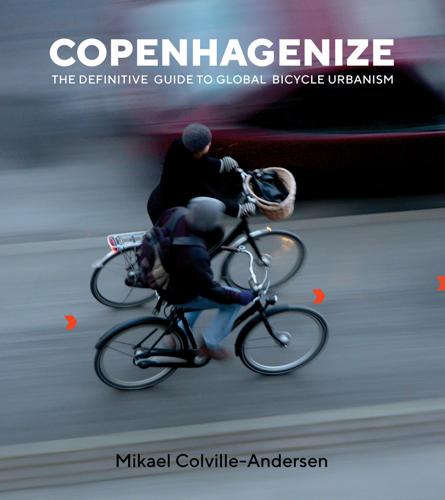
Copenhagenize: The Definitive Guide to Global Bicycle Urbanism
by
Mikael Colville-Andersen
Published 28 Mar 2018
Library of Congress Control Number: 2018931245 All Island Press books are printed on environmentally responsible materials. Manufactured in the United States of America 10 9 8 7 6 5 4 3 2 1 Keywords: A2Bism, arrogance of space, bidirectional bike lane, bicycle urbanism, bike lane, bike superhighway, bus stop, climaphobia, contra-flow bike lane, desire lines, infrastructure design, intermodal, life-sized city, protected bike lane, sharrow, urban design I wish to thank the many members of my team at Copenhagenize Design Company for their support and help in writing this book. In particular, Michael Wexler, James Thoem, Stephanie Patto, and Darcy Miller. Thanks to Lorenz Siegel and Christina Steinmayr for their amazing design and layout.
…
In Copenhagen, roughly 50 percent of the bicycle infrastructure had been removed in the two decades of redesigning the streets for cars. Copenhagen has sprawl. The third-largest urban sprawl in Europe, actually. People can commute for a hour and a half or more by car to get to the city, as in many other places. Intermodality is the key. Riding your bicycle to the local train station and combining travel modes helps increase bicycle share. The main point here is that few people are going to ride long distances. More than a century of experience would dictate this. Sure, as quoted previously, many “found the bicycle a convenient form of transport for distances up to, say, ten miles.”
…
Make it less competitive in travel times. All the campaigns in the world for Ride a bike! It’s good for you! Save a polar bear on your bike today! are completely irrelevant and a colossal waste of money unless we are doing that fourth line. Cyclists, pedestrians, and public-transport users are by nature intermodal. Personally, if my tire is flat in the morning, I chuck the bike into the bike shop and walk to the metro to get to work. With 600 shops serving 600,000 people—I have 50 of them within a five-minute bike ride—it is the easiest option. It only costs about $8, on average, to have a flat tire fixed.

Stephen Fry in America
by
Stephen Fry
Published 1 Jan 2008
Within that there are the following subsystems: Principal Arterials: these are highways in rural and urban areas which provide access between an arterial and a major port, airport, public transportation facility, or other intermodal transportation facility. The Strategic Highway Network (the Orwellian sounding STRAHNET): a network of highways important to the United States’ strategic defence policy providing defence access, continuity and emergency capabilities for defence purposes. Major Strategic Highway Network Connectors: highways which provide access between major military installations and highways which are part of the Strategic Highway Network. Intermodal Connectors: these highways provide access between major intermodal facilities and the other four subsystems making up the National Highway System.
…
Intermodal Connectors: these highways provide access between major intermodal facilities and the other four subsystems making up the National Highway System. The Eisenhower Interstate System. I have no idea what the foregoing means either. I wouldn’t know an ‘intermodal facility’ from a lettuce leaf. The important fact for our purposes is that there is a whole separate network within the main Highway System, the Eisenhower Interstate System–the equivalent of our motorway network but more, so much more. The Eisenhower Interstate System You might blanch at the prospect of me enlarging any further on this subject, but–as they say in call centres–bear with me, it really is jolly interesting. It concerns, after all, the greatest public-works project in the history of our species.

Street Smart: The Rise of Cities and the Fall of Cars
by
Samuel I. Schwartz
Published 17 Aug 2015
The College of Charleston and the Citadel, the Military College of South Carolina, between them have more than fifteen thousand students and three thousand faculty and staff. At the northern end of the peninsula, the city—or, rather, the Charleston Area Regional Transportation Authority, or CARTA—is building a state-of-the-art transportation hub, the North Charleston Intermodal Transportation Center, which will connect local transit, like buses and taxis, with both Amtrak and the Southeastern Stages intercity bus network. Charleston has a strong and growing economy. The Port of Charleston remains one of the country’s busiest, and in 2011, Boeing built a new assembly site for their Commercial Airplanes division in North Charleston.
…
When Charleston passed the nation’s first preservation law in 1931, the city was already 261 years old. The law, which made it impossible to tear down much of anything, therefore also made it impossible to build anything either, so the core of Charleston has escaped most kinds of development-driven sprawl. Charleston’s fundamental transportation need isn’t too hard to figure out. With the Intermodal Facility and Boeing to the north, and most of the Digital Corridor, the universities, and the tourist destinations to the south, the peninsula has two potential anchors for a multimodal, multinodal system. CARTA already operates a traditional, fixed-route, motor bus system both in the peninsula and the surrounding areas, and, downtown, it runs a trolleybus system known as DASH, for the “Downtown Area Shuttle”: three different lines circulating along loops through the southern end of Charleston’s peninsula, with stops at the Broad Street shopping district, the City Market, the aquarium, and both colleges.
…
According to the 2010 transport “microcensus” performed by the Civil Engineering Office of the City of Zurich every five years, 32 percent of Zurich’s residents use streetcars and trolleybuses regularly, while only 26 percent depend on cars (and motorcycles/motorbikes). Fewer than half the city’s households even own a car or motorcycle. In addition, while “only” 15 percent of all trips are intermodal (that is, involving two or more modes for the same trip), nearly 60 percent of the city’s residents are multimodal (that is, they use different modes for different trips depending on their daily needs and schedules). And they haven’t forgotten active transportation, either: 36 percent of all trips in Zurich are made on foot, and another 6 percent are by bicycle.
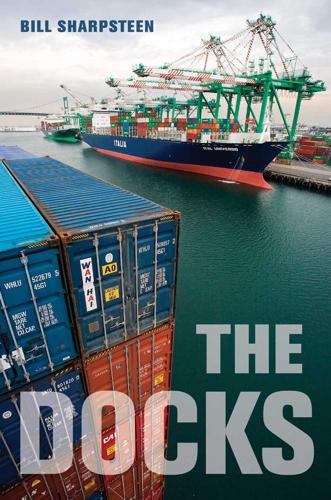
The Docks
by
Bill Sharpsteen
Published 5 Jan 2011
“Goods Movement.” www.portoflosangeles.org/maritime/good_move ments.asp (accessed May 21, 2010). ———. “Intermodal Logistics and Port of Los Angeles/Port of Long Beach Rail Infrastructure.” Public rail workshop presentation, October 22, 2009. ———. “Los Angeles Harbor Commission Approves San Pedro Waterfront Project with Plans for Additional Cruise Ship Facility in Outer Harbor.” Press release. September 30, 2009. ———. No Net Increase Task Force. Minutes of meeting, October 27, 2004. ———. “Rail and Intermodal Yards.” www.portoflosangeles.org/facilities/rail _intermodal_yards.asp (accessed May 21, 2010). ———. “Report to Mayor Hahn and Councilwoman Hahn by the No Net Increase Task Force.”
…
Allen Development makes a compelling case for the hub, arguing that cargo is more efficiently distributed away from the port in a central location such as Dallas, which is connected to the West Coast and the rest of the country by rail or interstate freeways. Beyond that, my eyes glaze over. Somehow, with all this geeky talk about intermodal point exchange, cross-dock this or that, and logistics something-or-other, I’ve lost the reason why I’m here in Dallas. I want to know how companies, their employees, and plain old consumers are affected by what happens at the Port of Los Angeles, some 1,200 miles away by road or rail. When the longshoremen and employers squabble, or if the Coast Guard shuts down the port because a suspicious package turns out to be a bomb (or not), what happens to places where the port is barely on anyone’s radar?
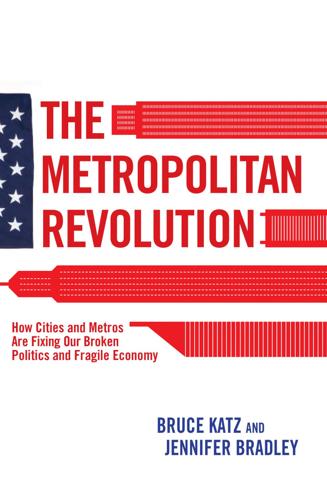
The Metropolitan Revolution: How Cities and Metros Are Fixing Our Broken Politics and Fragile Economy
by
Bruce Katz
and
Jennifer Bradley
Published 10 Jun 2013
Helen Zimmern, The Hansa Towns (New York: G. P. Putnam’s Sons, 1889), p. 151. 97. Walter Zinn, “The Hanseatic League and the Intermodal Nature of Multinational Business,” Michigan State University, p. 92. 98. Lardas, “The Heritage of the Hansa”; Jennifer Mills, “The Hanseatic League in the Eastern Baltic,” University of Washington, May 1998 (www.conflicts. rem33.com/images/The%20Baltic%20States/hansa_ost.htm). 99. Mills, “The Hanseatic League in the Eastern Baltic.” 100. Ibid. 101. Zinn, “The Hanseatic League and the Intermodal Nature of Multinational Business,” p. 86. 102. Zimmern, The Hansa Towns, pp. 80–81. 103. “C40 Cities: Climate Leadership Group,” 2013 (www.c40cities.org); New York City, “PlaNYC 2030” (www.nyc.gov/html/planyc2030/html/home/home. shtml); City of Copenhagen, “Global Challenges, Copenhagen Solutions” (www.sub site.kk.dk/sitecore/content/Subsites/CityOfCopenhagen/SubsiteFrontpage/Business/ Growth_and_partnerships/Strategy.aspx); “Guide to Copenhagen 2025” (Copenhagen: Monday Morning and Green Growth Leaders, 2012); City of Philadelphia, Mayor’s Office of Sustainability, “Greenworks Philadelphia” (www.phila.gov/ green/greenworks/index.html); C40 Cities, “Our Partners and Funders,” 2011 (www.c40cities.org/partnerships).
…
As chairman of the U.S. Senate Committee on Environment and Public Works, he was the major architect of the Intermodal Surface Transportation Efficiency Act of 1991, which gave metropolitan areas greater powers over the allocation of federal transportation funds. States have also tended to distort and distend metropolitan development through their interventions on governance, municipal taxation, school finance, land use, and zoning. See Richard F. Weingroff, “Creating a Landmark: The Intermodal Surface Transportation Act of 1991,” Public Roads 65, no. 3 (2001) (www.fhwa.dot.gov/publications/ publicroads/01novdec/istea.cfm).
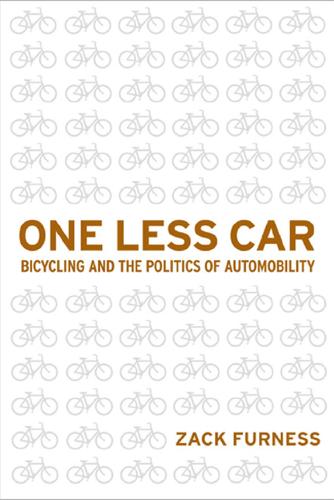
One Less Car: Bicycling and the Politics of Automobility
by
Zack Furness
and
Zachary Mooradian Furness
Published 28 Mar 2010
Federal financing for mass transit was virtually nonexistent until money was set aside in the Housing act of 1961, followed by the Urban Mass Transportation act of 1964, a piece of legislation providing roughly $375 million over a three-year period—a figure paling in comparison to the billions devoted to highway construction.25 it was not until 1973 that the Highway Trust fund was tapped for mass transit expenditures (minus funds for the actual operating costs, which were dropped under the threat of nixon’s veto), and the creation of an analogous Mass Transit account was similarly postponed until 1983. another eight years would pass before the federal government signed off on the intermodal Surface Transportation Efficiency act (iSTEa), one of the first pieces of comprehensive legislation to call for the inclusion of national pedestrian and cycling plans in state transportation planning. in other words, the first time walking and bicycling were seriously recognized as national/federal priorities, in terms of funding and the scope of the policy, was more than a century after the invention of the automobile. yet according to the national Center for Bicycling and Walking, more than 40 percent of all state Departments of Transportation had not even complied with iSTEa’s most basic requirement as of 2003: to develop a statewide, long-range plan for bicycles and pedestrians.26 The postwar redevelopment of the United States was problematic not only because it helped transform the metropolis into an autopolis but also because simultaneously it facilitated both mass suburbanization at home and the geopolitical policies necessary to ensure steady supplies of oil from abroad.27 Tragically, these processes occurred almost immediately following a period when public transportation and walking were common, when more than half of U.S. car owners claimed they could do without their cars, and when there were more than 12 million bicycles in use by 1948, up from 9 million in 1940.28 By contrast, cycling continued to find a place in everyday European life, particularly in England, where the cycling industry thrived and bicycles were widely used for both transportation and recreation prior to, and following, World War ii.29 lewis Mumford was among those who spoke to the problem of U.S. automobility as early as the 1950s, seeing cars not as the end result of technological Darwinism but as a problem to be remedied. in addition to penning books on the subject, he used his “Sky line” column in the New Yorker to wage a public battle against auto-centric planning and, more specifically, robert Moses’s catastrophically myopic vision of new york City as a driver’s paradise.30 in 1963, he stated: The motorcar shapes and forms.
…
news coverage of bicycle transportation increased both quantitatively and qualitatively in recent years for an additional set of interconnected reasons, including the sheer persistence and flak of vocal cycling advocates, the popularity of both urban cycling and physical fitness, and the mainstreaming of several U.S. bicycle advocacy groups in the early 1990s that tapped into the financial resources allotted to metropolitan planning and transportation networks through the intermodal Surface Transportation Efficiency act (iSTEa), thereby improving their capacity for activities like lobbying and public relations.49 The last decade has thus seen large advocacy groups effectively publicize national campaigns like Bike-to-Work Week, Safe routes to School, and Bicycle Friendly Communities, as well as more localized bicycle transportation initiatives.50 Smaller, volunteer-based advocacy groups have also been relatively successful at securing news coverage for grassroots community events like pittsburgh’s Bike Fest, initiated in 2005. national broadcast news stories on bicycle transportation are still few and far between, but the trend toward more coverage—and more substantive coverage—is both palatable and likely to increase due to a faltering U.S. economy, instability in the Middle East, and the prospects of oil and gasoline eventually returning to the highs achieved during the summer of 2008 (more than $144 per barrel and $4 per gallon, respectively). at the same time, news media have for the better part of the last three decades helped to produce a stereotype of urban cyclists as reckless, aggressive, and threatening to both pedestrians and motorists. in the following sections i examine these narratives to show how they problematize urban cycling and contribute to an overall climate of hostility against pro-bicycle and/or anti-car advocates in the United States.
…
World Bank, “a Decade of action in Transport: an Evaluation of World Bank assistance to the Transport Sector, 1995–2005” (Washington, DC: The international Bank for reconstruction and Development/World Bank, 2007), xvii. ibid., 63. Walter Hook, “Wheels out of Balance: Suggested Guidelines for intermodal Transport Sector lending at the World Bank—a Case Study of Hungary” (new york: institute for Transportation and Development policy, 1996). G. H. pirie, “The Decivilizing rails: railways and Underdevelopment in Southern africa,” Tijdschrift voor Economische en Sociale Geografie 73, no. 4 (1982): 221–228; H.

Road to Nowhere: What Silicon Valley Gets Wrong About the Future of Transportation
by
Paris Marx
Published 4 Jul 2022
In the 1980s, the DARPA Strategic Computing Initiative funded the Autonomous Land Vehicle project as part of its efforts to “bring new technologies to the battlefield.”9 The project made significant advances in the use of laser imaging and computer vision for autonomous navigation. One of the beneficiaries of that funding was Carnegie Mellon University, which used the money from DARPA to create its first Navlab autonomous vehicle. The experiment served as a foundation for future research aimed at civilian uses. To that end, the Intermodal Surface Transportation Efficiency Act of 1991 mandated the Department of Transportation (DOT) to “develop an automated highway and vehicle prototype from which future fully automated intelligent vehicle-highway systems can be developed.”10 To achieve its aims by 1997, it handed out nearly $100 million to partners in the private sector and university research centers, including the same team at Carnegie Mellon.
…
See Interstate Highway System Highway Trust Fund, 25 Hill, Steve, 148 Horan, Hubert, 102, 106, 107 horsedrawn carriages, 15–6 The Horseless Age (magazine), 66 housing prices, 128 Humphreys & Partners, 154–5 Hyperloop, 143, 155, 219, 225 IBM, 50 An Inconvenient Truth (documentary), 68–9 individualized transport, Musk on, 188 Infinite Detail (Maughan), 129 Infrastructure Investment and Jobs Act (2021), 127 Instacart, 111 Instagram, 61–2 Intel, 40 Intermodal Surface Transportation Efficiency Act (1991), 119 International Energy Agency, 74–5 International Rights Advocates, 72 internet origins of, 50 privatization of infrastructure of, 55–6 “internet of landlords,” 197–8 Interstate Highway System about, 24, 46, 140, 221 controlled access highways (freeways/motorways), 21–2 development of streets, 11–2 double-decker highways, 151 in Los Angeles, 140–1 in Paris, 210–1 reconceptualization of, 23 slowdown of highway construction boom, 26 traffic and, 142–4 Isaac, Mike, 110 Jacobs, Jane, 230, 232 as campaign leader against urban renewal, 26 The Death and Life of Great American Cities, 26–7 Japan, innovation in, 45 Jarvis, Charlie, 193 jaywalkers, 124–7, 215–6 Jennings, Lois, 42 jitneys, 89–91, 92, 108–9 Jobs, Steve, 36–7, 42, 44 Jump, 166–8 Kalanick, Travis, 5, 92–4, 97, 105, 113, 116 Kamoto Copper Company, 73 Kara, Siddharth, 73 Katy Freeway, 140 Kelly, Kevin, 53 Kenney, Martin, 182 Khosrowshahi, Dara, 133–4 Kirsch, David, 65, 66, 71, 86 Krafcik, John, 138 Kroger, 172–3 Labour Party, 209 Labrador, Canada, 80 Laceese, Francis, 80 Latin America bike lanes in, 171 Pacto Ecosocial del Sur, 225 rapid transit systems in, 215 leasing model, for taxi drivers, 101–3 Le Guin, Ursula K.
…
See bicycles Seattle, WA, ride-hailing services in, 99 Securities and Exchange Commission (SEC), 138 Sedran, Thomas, 129–30 self-checkout, 194–5 self-driving cars accidents with, 132–5 Autonomous Land Vehicle project, 119 Brin on, 114–5 challenges of, 126, 129–30 environmental dilemmas and, 131–2 Google, 6 Intermodal Surface Transportation Efficiency Act (1991), 119 Kalanick on, 116 Navlab autonomous vehicles, 119–20 Ng on, 126 pedestrians and, 127 pricing of, 127–8 pulp science fiction and, 118 Radio Corporation of America (RCA) and, 118 software for, 122–3 speed and, 123–4 Tesla’s Autopilot system, 137–8 Tsukuba Mechanical, 119 VaMoRs, 119 Sepulveda Pass, 141 Shanghai Gigafactory (Tesla), 83 Sheffield, UK, docked bikeshare system in, 170–1 Sheller, Mimi, 158, 207 Shell Oil City of Tomorrow, 2 Shill, Gregory, 30 shipping industry, 49 shut-in economy, 196–7 Sidewalk Labs, 228–30 Silicon Valley, 37–8, 44–5 skates (platforms), 146–7 Skyports, 154–5 Small Business Investment Company, 55 smart homes, 60–1 smartphone apps, 55, 181, 194–5 Smiley, Lauren, 196 Social Bicycles (SoBi), 167–8 Socialist Left Party, 209 social media, 61–2 SolarCity, 55, 143, 188 solar panels, Musk on, 188–9 Southern State Parkway, 26 Soviet Union, 39 space program, 48 SpaceX, 55, 144, 148, 150–1 speed limiter referendum, 19–20 speed limits, 18–20 Sputnik I satellite, 39, 45 standardized containers, increasing use of, 49 Standard Oil of California, 21 Stanford Industrial Park, 40 Stanford Research Institute, 54–5 Stanford University, 39–40, 55, 120 Stark, Tony, 70 Starley, John Kemp, 160, 162 Starship Technologies, 172, 173–5, 176–7 Stop de Kindermoord, 205 streetcars, 12–3, 15, 21, 92, 160 “subscriber city,” 197 suburbanization, 23 suburbs, 12–3 superhighway plan (Detroit), 22 supply chains, 50 Surface Transportation Policy Project, 141 surge pricing, for ride-hailing services, 100 Swisher, Kara, 116–7 Taft-Hartley (1947), 112 taxi medallions, 104–5 taxi services about, 95–6, 101–2, 104–5 industry regulation and, 107, 110–1, 185 Taylor, Isaac, 122 TCP/IP protocol, 50 TechGirls Canada, 228–9 tech industry development of, 9–10 growth of, 4, 180–5 speed of technological innovation, 48 technological solutionism, 59 Tesla, 5–6, 55, 63–4, 70, 72, 73, 82–4, 85–6, 116, 137–8, 143, 147, 158–9, 188, 189, 190 Tesla, Nikola, 70 Texas, Interstate Highway System in, 140 Thacker Pass, NV, 79, 226 Thiel, Peter, 46–7 Thrun, Sebastian, 121 Toronto, Canada, 228–30 Toyota, 116, 121, 122 train system in France, 220 in North America, 218–9 transportation bus system, 21, 215, 219 computerized planning systems for, 130 flying cars, 151–2, 159 history of, 7 jitneys, 89–91, 92, 108–9 Navlab autonomous vehicles, 119–20 present-day dominance of, 34–5 taxi services, 95–6, 101–2, 104–5, 107, 110–1, 185 three-dimensional vs. two-dimensional, 145 train system, 218–9, 220 tunnels for, 144–51, 154–5, 158–9, 189 vertical takeoff and landing vehicle (VTOL/eVTOL), 152–5, 157, 158 walking as primary means of, 12 Trudeau, Justin, 79–80, 228 Trump, Donald, 78 Tsukuba Mechanical, 119 tunnels, for transportation, 144–51, 154–5, 158–9, 189 Turner, Fred, 41, 43, 52 Turner, Matthew, 141–2 Uber about, 115 acquisition of Jump, 166–8 Advanced Technologies Group (ATG), 133, 134–5 benefits of, 94 campaigns for, 103 changed from Ford Fusion to Volvo XC90 SUVs, 134–5 compared with taxi services, 95–6 core business of, 93 costs for, 107–8 Covid-19 and, 108 customer base for, 100–1 divisions of, 153–4, 184 driver pay for, 103–4, 107 effect on traffic of, 100 employee classification for, 111–2 founding of, 181 Greyball and, 110 growth of, 97, 105–6 industry regulation and, 101–2, 107, 110–1, 112–3, 156, 174, 185 loss of money by, 106–7, 184–5 marketing by, 158–9 media representation of, 94–5 micromobility services of, 166–9 model of, 102–3 in New York City, 98–9 origins of, 92–3, 109 pricing for, 184 promises made by, 186 pulls out of China, 152 refocus on ride-hailing and food delivery services, 184–5 safety record of, 134, 135–6 in San Francisco, 97–8 walking vs., 191 Uber Air, 153–4, 155, 157, 159 Uber Copter, 155–6 Uber Eats, 184–5 Uber Elevate, 152, 154, 159 unemployment rate, 95–6 unions, for taxi drivers, 101–2 United Kingdom (UK) docked bikeshare system in, 170–1 ecommerce in, 193 University of Technology Sydney, 75 University Paris-East, 169–70 Unsafe at Any Speed (Nader), 27–8 Untokening collective, 218 Urban Challenge, 120 urban renewal strategy, 26 Urry, John, 32–3, 143 US Air Force, 50 US Department of Defense, 50 US-Japan Semiconductor Trade Agreement (1986), 45 US National Labor Relations Act, 102 VaMoRs, 119 Vansintjan, Aaron, 222 Vasquez, Rafaela, 132, 135 Vélib’ bikeshare system, 210 venture capitalists, 186–7, 199 vertical takeoff and landing vehicle (VTOL/eVTOL), 152–5, 157, 158 Very Far Away from Anywhere Else (Le Guin), 202 Vietnam War, 39, 40, 43, 49 VoiceOver, 175 Volkswagen, 77, 78, 129–30 Volocopter, 152 Volvo XC90 SUVs, 134–5 Walker, Jarrett, 59, 142–3, 181–2 walking, as means of transportation, 12, 191 Washington, DC, ride-hailing services in, 99 Waterfront Toronto, 228–9, 230, 231 Waymo, 133, 138, 186 web 2.0, 57 WeWork, 181, 182–3 white people, mortgages and, 29 Who Killed the Electric Car?
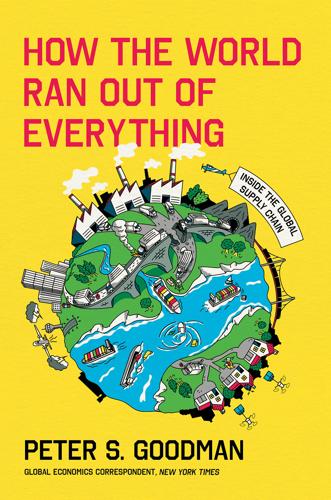
How the World Ran Out of Everything
by
Peter S. Goodman
Published 11 Jun 2024
People Are Leaving,’” Railway Age, April 25, 2022, https://www.railwayage.com/regulatory/it-is-getting-worse-people-are-leaving/. 3. “streamline operations”: “Chicago Intermodal Simplification and Service Update from Kenny Rocker, EVP, Marketing & Sales,” announcement no. CN2019-28, Union Pacific, May 2, 2019, https://www.up.com/customers/announcements/customernews/generalannouncements/CN2019-28.html. 4. by one-fifth: Union Pacific Corp. Form 10-K, 2020, 32. 5. $2.6 billion in dividends: Ibid., 3–4. 6. “inland intermodal terminals”: Quoted in Ari Ashe, “UP Suspending USWC-Chicago Hub Services to Clear Global IV Boxes,” Journal of Commerce (July 15, 2021). 7. coming in from Chicago: Bill Mongelluzzo, “UP Suspends Receipt of Westbound Boxes at LA-LB Facility,” Journal of Commerce (October 25, 2021). 8.
…
Its freight volumes dipped by 6 percent that year, but the company still managed to pay out $2.6 billion in dividends5—more than a third of its earnings. Two years later, in July 2021, as imported goods swamped American docks, Union Pacific halted shipments of containers traveling east from West Coast ports. The railroad described this measure as unavoidable given “significant congestion at our inland intermodal terminals6, most notably in Chicago.” That move revealed the ruse. The action plan that had accompanied the railroad’s rhetorical reach for simplification, efficiency, and precision had produced none of those things. Rather, it had generated new vulnerabilities. Much as consultancies like McKinsey had warped the sensible thinking behind Toyota’s concept of Just in Time, the railroads had deployed Precision as the justification to ransack their own operations for the enrichment of shareholders.
…
See rail freight and Precision Scheduled Railroading Presburger, Isaac, 314, 316 Preslow, 314 Procter & Gamble, 262–63 procurement, 82–89 demand change and supply chain inflexibility, 87–89, 153 demand reduction and COVID-19 spread (early 2020), 84–87 planning for, 82–84, 89 Pudong Prime International Logistics, 192 Pump, Juergen, 150 rail freight and Precision Scheduled Railroading, 209–26 Biden, Congress, and strike threat, 218–20, 223–25 dwell time, 212–13 East Palestine (Ohio) derailment and, 225 Ford’s assembly line model and, 221–23 intermodal terminals for, 211 Norfolk Southern’s cost cutting and, 216–20 operating ratios, defined, 212 profits from Precision, 209–16, 219, 225–26 shippers and pandemic delays, 210, 213–15 railroads, 193–208. See also rail freight and Precision Scheduled Railroading Chinese workers of nineteenth century, 23, 198 contemporary corporate profit of, 194–95, 204–5, 208 contemporary importers’ use of, 193–94 early history of, 45, 194–204 rail freight, 209–26 (see also rail freight and Precision Scheduled Railroading) regulation of, nineteenth-century, 205–6 sick leave provided by (2023), 345 Staggers Rail Act (1980) and, 206–8 trucking as competition to, 95, 206 ranching business, 259–62, 268–71, 274–80.

Only Humans Need Apply: Winners and Losers in the Age of Smart Machines
by
Thomas H. Davenport
and
Julia Kirby
Published 23 May 2016
Along the way we’ll introduce you to some good examples of people who have successfully stepped into automated systems in their work, including: • Shane Herrell, digital marketer at SAS Institute; • Mike Krans, an expert in insurance underwriting automation; • Andy Zimmermann, a teacher in the New York City schools; • Alex Hafez and Ralph Losey, who have stepped into legal automation in a couple of different ways; • Dr. Doris Day, an example of stepping in with regard to health-care (dermatology) automation; • Edward Nadel, who monitors risk for Internet startup Circle; • Travis Torrence, an intermodal dispatch analyst at the trucking firm Schneider National. Stepping In Has Taken Place Before There have probably always been people who bridged technical and business environments. As long as there have been complex technologies, there have been people who “stepped in” to understand them and to help apply them to solving business and organizational problems.
…
Remember, “purple people” are purple because of their mixture of blue (technology) and red (business) interests. Or maybe the colors are the other way around, but in any case it’s a mixture. A good example of this combination can be found at Schneider National, one of North America’s largest truckload, logistics, and intermodal services providers. It’s a complex business, moving close to 18,000 daily loads, utilizing more than 13,000 drivers and 50,000 trailers/containers. To manage and optimize this complexity, Schneider has been implementing various forms of analytical decision-making for a couple of decades. The analytics are increasingly automated as well, from guiding order-acceptance decisions to recommending optimal appointment times to automatically matching loads with drivers.
…
The analytics are increasingly automated as well, from guiding order-acceptance decisions to recommending optimal appointment times to automatically matching loads with drivers. Each hour, Schneider’s planning systems evaluate millions of potential driver tours over a multiday horizon. One person who has stepped into such systems at Schneider is Travis Torrence. He’s an Atlanta-based “Intermodal Dispatch Analyst” at Schneider and has had the job for a couple of years. During his time, Schneider introduced a new version of its dispatch optimization system, Short Haul Optimizer (SHO), which matches container loads to available drivers. It’s Torrence’s job to work with the SHO system to dispatch the markets he manages.

The Stack: On Software and Sovereignty
by
Benjamin H. Bratton
Published 19 Feb 2016
In this enforced translation of any thing into the status of information within a system, all things may possess their worlds and be possessed by their worlds only to the extent that they possess the attributes necessary for intermodal communication with other platform systems. Whether for bits or atoms, numbers or nectarines, no impedance mismatch can disallow the activation of that intermodality, and so compatibility within a given scale as well as the interoperability between scales, becomes itself the critical vernacular definition of computability as an economic technology. As all systems come to mean information systems, then computation, which otherwise might be defined differently, comes to refer to “algorithms holding systems of information together.”
…
To engineer systems that coordinate the shuttling of units from one point to another with efficiency, adaptability, and flexibility is to compose within the rules laid down by other systems, larger and smaller, with which interaction is required. If two different systems share common protocols, then the subsystems of one can interoperate with subsystems of another without necessarily referring to any metasystemic authority. Systems swap material in this way, such that intermodality and intramodality come to enable one another: no standards, no platform; no platform, no Stack. The design of protocols, platforms and programs can be as speculative as needed, but the generativity of standards remains. Protocological interoperability works not only to componentize tangible things, but also to represent undetermined relations between things, events, and locations and to provide the means to compose that traffic in advance.
…
Beer's model posited a nested series of socioeconomic scales, from worker to nation, through which regulated information would be reported, analyzed, and governed. Sakamura's model distributes operations among widely dispersed components sharing data directly or indirectly for separate uses (e.g., industrial, civic, interpersonal) and so lubricating intermodal communication between people and people, people and things, and things and things. Beer's and Sakamura's visions are asymptotic. Both sought to design a platform infrastructure that would integrate a national society by integrating its material economies into a master computational system, but each is animated by a different conception of that task.
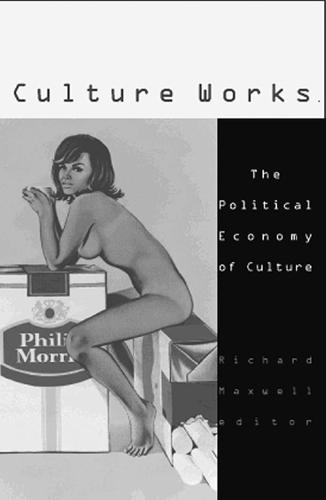
Culture works: the political economy of culture
by
Richard Maxwell
Published 15 Jan 2001
Jobs and manufacturing processes have been exported out of the United States to economically desperate and Western-dominated countries such as Mexico, Haiti, El Salvador, China, Korea, Poland, Thailand, and Turkey, many of which have been forced by U.S.-led “structural adjustment” programs to become, more than ever before, the cheap labor pool for the wealthy world. Trade agreements privileging U.S., European, and Japanese capital, and the coordination of a rapid, 175 Susan G. D av i s international “intermodal” transport system of ports, shipping, long-distance trucking, and railroads, have accelerated the importation of very cheap goods into the United States.42 These changes in policy and the international division of labor have made mass-market discounters possible. Once again, as the world’s largest retailer, Wal-Mart provides a good example.
…
According to Crawford, the North American system of scaled malls—from neighborhood to community to regional to superregional— accounts for more than 53 percent of all purchases in the United States and Canada. 40. Jackson, “All the World’s a Mall,” 1114. 41. In some cases, clothing and millinery manufacturing took place on the upper floors of a store building, but still out of sight. 42. On “intermodalism,” see William Leach, Country of Exiles: The Destruction of Place in American Life (New York: Pantheon Books, 1999), 31–57. 43. Honduras staggers under a $4.3 billion foreign debt load (National Labor Committee, “Wal-Mart Sweatshops in Honduras,” Web-published report: http://www.nlcnet.org/ walmart/honwal.html [June 28, 1999]). 44.
…
See also Enchantment Fox, Danielle, 22–59 Fox TV, 135–40, 234 France, 11, 48, 63, 184 Frasier, 231 Freedom, discourse of, 24–30, 40–51 Freud, Sigmund, 87 Frohnmeyer, John: NEA Chairman under Bush, 46 Frow, John, 237, 241 Fukuyama, Francis, 154 Gates, Bill, 207, 240 General Electric, 41, 136, 210 General Federation of Women’s Clubs, 90 General Foods, 94 General Motors, 86, 95, 178 Germany, 27, 48, 141, 184, 227 Giuliani, Rudolph W., 50 Globalization, 2, 3, 16–20, 23–31, 35, 38–49, 52–56, 60, 63, 68, 118, 165, 175, 181–84, 190, 208–18, 229, 233 Goebbels, Joseph, 227 Great Depression, 94, 165 Gruen, Victor: indoor malls, 172 Guilbaut, Serge, 29, 30, 52 Haacke, Hans, 22, 48, 52–53 Hahn, Ernest, 178 Haiti, 175 Hammer, MC, 119 Hanchett, Thomas, 171 Hanks, Nancy: NEA chair under Nixon, 43 Harlem Renaissance, 108 Harvey, David, 232 Hazard, Katrina, 114 Helms, Jesse, 46, 50 Herman, Edward, 211, 245 Hip-hop, 116–21, 128 Hitchcock, Alfred, 229 Hollywood, 204, 216, 227, 231–33, 238 Honduras, 176 Hong Kong, 3, 176 Hypertext transfer protocol (http), 201 IBM, 185, 205, 240 Identity, 43, 71–78, 87, 108, 119, 141, 155, 175, 182, 244 Ideology, 24–25, 28–39, 45, 50, 98, 155, 188, 217, 236 I Love Lucy, 183, 235 Imagination, 16–17, 20, 72–76, 111, 131, 167 India, 109, 119, 126, 128, 141 Individualism, 14–15, 17, 23, 34, 45, 237–41, 243; paradoxes of, 12–17, 30, 36, 38, 40, 45, 187–89, 235–38, 241, 243 Indonesia, 44, 125 Inequality, 8, 163–64, 171, 177, 197–98, 203, 218–19 Intel, 9, 123–26, 205, 209 255 Index Intellectual property, 1, 109, 225, 228, 233–43 Intermodal transport system, 176 International division of labor, 2, 176 International Olympic Committee (IOC), 148, 150, 153 Internet, 3, 13, 16, 19, 60, 100, 128, 132, 136, 148, 163, 197–224, 238–45 Internet Explorer (IE), 206 Internet service provider (ISP), 202, 207–8 In These Times, 245 Ireland, 64 Italy, 65 Jackson, Kenneth, 173, 191 Jackson, Michael, 109, 113 Jacobson, Marjory, 45 Jameson, Fredric, 128, 134 Japan, 11, 65, 134, 141 Jar Dance, 114 J.

Big Data at Work: Dispelling the Myths, Uncovering the Opportunities
by
Thomas H. Davenport
Published 4 Feb 2014
For example, at trucking Chapter_08.indd 197 03/12/13 12:57 PM 198 big data @ work Big Data at Schneider National Schneider National, one of North America’s largest trucking, logistics, and intermodal services providers, has been pursuing various forms of analytical optimization for a couple of decades. What has changed in Schneider’s business over the past several years is the availability of low-cost sensors for its trucks, trailers, and intermodal containers. The sensors monitor location, driving behaviors, fuel levels, and whether a trailer/container is loaded or empty. Schneider has been transitioning to a new technology platform over the last five years, but leaders there don’t draw a bright line between big data and more traditional data types.
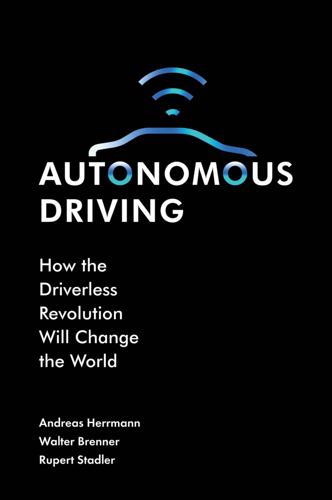
Autonomous Driving: How the Driverless Revolution Will Change the World
by
Andreas Herrmann
,
Walter Brenner
and
Rupert Stadler
Published 25 Mar 2018
As the costs for a driven mile are about $1, this yields a potential revenue volume of $10 trillion. These differing views of the market result in differing strategies and tactics for the development of products and services to generate sales and revenue. Autonomous mobility is also leading to completely new possibilities for intermodal transport, as mentioned above, especially involving rail and road Autonomous Driving Is a Reality 17 Box 1.1. Statement by Matthias Wissmann Matthias Wissmann, President of the German Association of the Automotive Industry (VDA) The German Association of the Automotive Industry (VDA) is working on the framework conditions so that automated driving will soon become possible in Germany and the European Union.
…
The strengths of the railway the fast transport of many people and goods into the middle of densely populated cities and agglomerations will continue to form the backbone of the mobility and logistics chains in the future. SBB will increasingly develop railway stations into real mobility hubs. In addition to an attractive range of services, they offer optimised intermodal connections and simplify the combined mobility for our customers. The Swiss Railway Corporation is not only the biggest transportation company in Switzerland, it is also one of the country’s biggest real-estate developers. The portfolio comprises about 4,000 plots of land, including areas in first-class city locations, and about 3,500 buildings.
…
In recent years, the region has become a centre for developing innovative residential and traffic concepts. Currently, luxury apartments are being built at premium locations with a wide selection of shops, cafes, parks and recreational and sports facilities. The traffic concept has been integrated into urban planning, which means that several new opportunities are available for designing intermodal mobility. Public-transportation stops are located at all traffic hubs, especially the ones where people can transition to personal transport. Beyond that, there are also countless services for ‘last-mile’ mobility, including a shared fleet of electric vehicles. TRAFFIC AND ART In recent years, photographer Eric Fischer (https://flowingdata.com/tag/ericfischer/) has used people’s geotags to create intriguing maps and spatial images.

Frostbite: How Refrigeration Changed Our Food, Our Planet, and Ourselves
by
Nicola Twilley
Published 24 Jun 2024
Forty years after the invention of refrigerated tuna coffins, the Atlantic’s previously plentiful bluefin had migrated by air at such a rate that they had become a critically endangered species. II. Reefer Madness After graduating from Cornell with a physics degree in 1976, Barbara Pratt spent her twenties living in a fridge. For the next seven years, she traveled and worked inside a refrigerated intermodal container, or “reefer,” as they’re called in the industry, circling the globe alongside Peruvian asparagus and Mexican mangoes. Her little-known adventures laid the groundwork for today’s globalized food system. We met at her 180-acre fruit farm in Westchester County, an hour’s drive north of New York City, on a gorgeous late-September day.
…
Still, when the Ideal X arrived in Houston five days later and those fifty-eight containers were swung off the ship, set down on fifty-eight separate trailer chassis, and sent on their various ways the very same afternoon, it represented enough of a success that McLean’s fledgling Pan-Atlantic Steamship Company expanded, rebranding itself as Sea-Land Service, Inc., to better describe its trailblazing vision of a seamless, intermodal, truck-to-ship-to-truck transportation network. Over the next few years, other companies took notice and began to follow McLean’s example. In keeping with the general lack of fanfare surrounding the maiden voyage of the first shipping containers, no one seems to have bothered to record what was transported inside them.
…
This was the real significance of McLean’s innovation and the Ideal X’s maiden voyage: by shrinking both the time and the cost involved in maritime trade, they made today’s just-in-time global supply chains possible. Despite these enormous advantages, container shipping took a while to catch on. Railways and trucking companies were initially reluctant to embrace this new intermodal form of transport: their existing cargo carriages and trailers represented a significant sunk cost. Throughout the sixties, as dockworkers protested at the prospect of losing their jobs, port authorities dithered about whether it was worth investing in the new cranes and facilities needed to handle shipping containers.
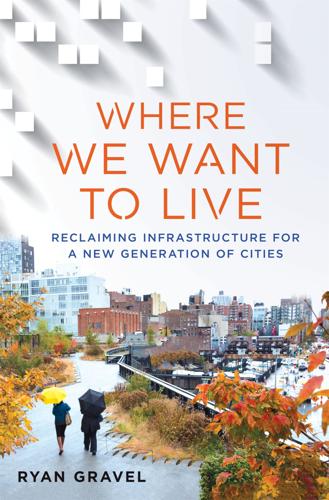
Where We Want to Live
by
Ryan Gravel
Published 2 Feb 2016
By the time the trains disappeared and the west side had transitioned to become almost exclusively African American, the utility of the railroad as a through route was physically broken by the construction of a new transit line to Bankhead, which opened in 1992. Similarly, the controversial construction of a new intermodal freight transfer facility at Hulsey Yard in the poor white community of Cabbagetown and the poor black neighborhood of Reynoldstown severed the southern end of Southern Railway’s belt in the 1980s. It also broke off the northern end of the Atlanta & West Point Belt Line, which was used to build a new interchange with I-20 and provide trucks better access to the yard.
…
I got to experience the river firsthand back in the summer of 2011 when Leigh Christy, a former colleague at Perkins+Will’s office there, introduced me to some of the primary players. She knew them well because she had managed a collaborative pro bono effort the previous year to reimagine the Piggyback Yard, a 200-acre (81-ha) rail yard and intermodal transfer facility just opposite the river from downtown. I was mesmerized by what they were doing. Like the railroads in Atlanta, the Los Angeles River gave the city its original reason for being and nourished its early cultural life and economy, but many people today don’t even know Los Angeles has a river.
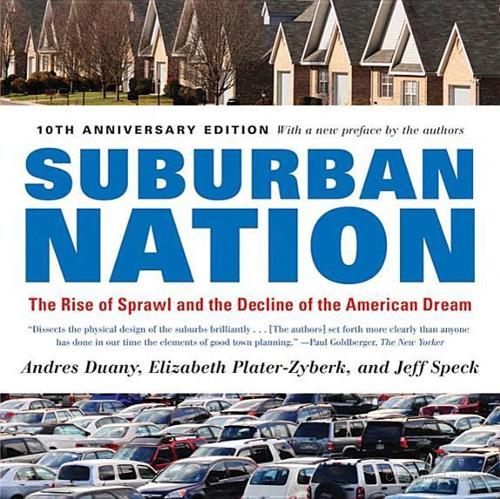
Suburban Nation
by
Andres Duany
,
Elizabeth Plater-Zyberk
and
Jeff Speck
Published 14 Sep 2010
Only within a neighborhood structure will residents readily walk to a bus stop or tram station. The sole alternative to neighborhood-based transit is the park-and-ride, which could bring suburbanites into the city on transit, if it only worked. Unfortunately, park-and-ride is just another way of saying “intermodal shift”—switching from one form of transportation to another. This is a transit engineering bugaboo, since most commuters, once they’ve settled into the driver’s seat, will tend to cruise all the way to their final destination. If transit is to work, its users must start as pedestrians. While park-and-ride has been effective along old established rail corridors such as Philadelphia’s Main Line and the Long Island Railroad, it has not had much success elsewhere.
…
Department of (HUD) Houston HOV (high-occupancy vehicle) lanes Howard, Ebenezer Howard, Philip ideology, architectural incentives: federal; state income, segregation by incubators Indianapolis infill projects, see urban infill infrastructure; allocation of state funds for; civic institutions as; and development costs; for new towns and villages; required by automobiles, see roadways; taxes and inner cities; amenities of; cleanliness and safety of; greenfield development as drain on; interdependence of suburbs and; investment security in; marketing to investors of; mixed-used development in; physical health of; retail management in; schools in; suburban competition with Institute of Traffic Engineers (I.T.E.) Interior, U.S. Department of intermodal shift intersections; curb radii of interstate highways Jackson, Kenneth Jacobs, Jane Jefferson, Thomas jobs, location of; in new towns and villages Johnson, Lady Bird Journal of Applied Social Psychology Kansas City (Missouri); Country Club District Kay, Jane Holtz Kentlands (Maryland); alleys in; architectural style in; mixed housing types in; street widths in Key West (Florida) Kinko’s Kraus, William Kruse, Jill Kunstler, James Howard labor movement Laguna West (California) Lake Street (Chicago, Illinois) landscaping Langdon, Philip large-lot development Lasch, Christopher Las Vegas latent demand leasing, proactive Le Corbusier Levittown life safety litter; elimination of live/work units loan programs, federal Locally Undesirable Land Uses (Lulus) local municipalities, policies of location, property value based on location-efficient mortgage lofts Long Island Railroad Longmont (Colorado) Los Angeles; automobiles in Loudon County (Virginia) LUTRAQ McCool, Lorne McDonald‘s MacKaye, Benton McMansion Madison (Wisconsin) Maine main streets; of new towns and villages; office parks versus; shopping centers versus malls; underground, in inner cities; see also shopping centers management techniques, II; crime control and; retail Manhattan (New York City); Greenwich Village; Times Square; Upper East Side Mariemont (Ohio) market experts Markham (Ontario) Maryland; see also specific municipalities Mashpee Commons (Massachusetts) mass transit, see public transit master plans; public participation in Meier, Richard merchandising merchants’associations Merrick, George Metropolitan Planning Organizations Miami-Dade County (Florida); Coconut Grove; Little Havana; Metro-Rail; Miami Beach; Pro Player Stadium; South Beach Middleton Hills (Wisconsin) mile-square grid Minneapolis—St.
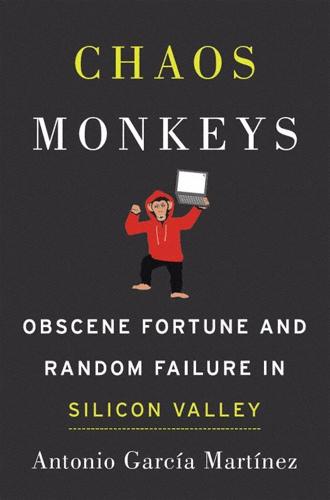
Chaos Monkeys: Obscene Fortune and Random Failure in Silicon Valley
by
Antonio Garcia Martinez
Published 27 Jun 2016
Each part increased in bulk till he became a mountain, and heaven with all its stars rests upon his shoulders. —Thomas Bulfinch, Bulfinch’s Mythology FEBRUARY 28, 2013 Any idea who Malcom McLean was? I bet not. But that one man changed our economy more than practically anyone else in the twentieth century. McLean was the inventor of the intermodal container, those metal boxes piled into immense heaps on the cargo ships coming from China. The genius of the container is that the entire workflow around transporting physical goods is standardized on the same 8×8×40 box. Manufacturers load goods onto eight-foot-wide palettes straight into the box.
…
The box becomes a freight car when loaded onto railroad wheels, and once it arrives at a ship, it is directly hefted aboard via those immense cranes that dot every modern port. Piled like Legos on the ship, the boxes arrive at another port and are loaded onto a truck frame, and are driven to their destinations. It’s universal: whether the ship docks in Singapore or Oakland, its cargo will be swiftly loaded and unloaded via the magic of containerization. Intermodal containers make our global supply chain possible. What’s that got to do with ads? Modern digital advertising has also settled on a containerized box—or, rather, a set of them. They’re known as Internet Advertising Bureau (IAB) ad units for desktop ads, and Mobile Marketing Association (MMA) ad units for mobile.
…
See also investors; venture capitalists (VCs) AdGrok, 113, 140–48 startups, 96, 154–55 VCs, 121 Game of Thrones, 324, 382 Gartrell, Alex, 476 Gates, Bill, 148–49, 151 Ge, Hong, 322–23 geeks, 29, 100, 107–8, 198, 268, 396 General Motors, 14, 25–26, 82 geographic data, 301 Getaround, 241–45 Gil, Elad, 192 Gladwell, Malcolm, 367 Gleit, Naomi, 356, 378 Gmail, 78, 103, 286, 324 go-big-or-go-home ethos, 206, 300 go-big-or-go-home strategy, 206 Golding, William, 444–45 Goldman Sachs credit crash, 425 credit derivatives, 26–27 departing, 29–31 ICE and, 492 joining, 15–16 partnership management structure, 16 post, 102 pricing quant, 16–18, 24, 29, 141, 207 traders’ contests, 21–24 trading credit indices, 14 Google acquisitions, 155 Ads, 85, 164 AdSense, 186, 275 AdWords, 106, 186, 222, 286, 300, 364 AdX, 461 alerts, 228 auction of keywords, 80–83 campus, 290 clickthrough rates, 451 employee pampering, 264 Facebook war, 492–93 Google Plus, 286–90, 308, 431–33, 492–93 Google Ventures, 78, 83 joining, 346 logo, 124 monetization, 186 PMs, 192 as publisher, 39 RTB, 41 scheming, 382 shuttle, 339 TGIF, 348 graffiti office art, 332–35 Graham, Paul (“PG”) advice, 231 essay, 46–47, 52–53 first meeting, 90 genius guru, 98 meeting with, 60–62 mythologies, 99 offer from, 63–64 on saying no, 187, 203 on startups, 87 startups and, 157–60 tsunami, 102 Graham, Robin Lee, 496 greed, 44, 74 Grindr, 487 GrokBar, 84–85, 184 GrokPad, 95, 100 Grouped: How Small Groups of Friends Are the Key to Influence on the Social Web (Adams), 367 Groupon, 78 Growth team, 373–79, 395 Guevara, Che, 354 Gundotra, Vic, 433, 493 H-1B visas, 70 hackers black-hat, 314 culture, 284 ethos, 284 hackathons, 262, 364 hacker way, 408 kludge and, 47 lingo, 84 multipurpose, 92 N00b and, 269 roles, 91 Zuckerberg and, 270 hacking all night, 406 building AdGrok, 123 configuration files, 92 defined, 47 on demo, 48 experience, 186 mobile, 229 people and products, 8 harassment, 66–68 Hart, Camille, 4–5 hashing, 387 hate speech, 315 Hemingway, Ernest, 106 Herodotus, 421 Herzl, Theodor, 496 Hoffman, Reid, 88 hogrammers, 400 home-brewing, 406 Houston, Drew, 175 HTC, 282 hybridizing, 341 Hykes, Solomon, 119 IBM, 20, 70, 148–49, 325 ID for Advertising (IDFA), 485 identity consumption patterns and, 385 Facebook, 382, 440 hashing and, 387 matching, 434, 438, 442, 466 name and, 381–82 online, 265, 477 PII, 395 work, 285 immigrant workers, 68–72 initial public offering (IPO) drawn out process, 247 Facebook, 284, 309, 342, 358, 371, 378, 399 lockout period, 409, 495 reevaluation, 417–20 on Wall Street, 124 Zuckerberg and, 342 Instacart, 50 Instagram product department, 493 user growth curve, 490 Intel, 70, 122 intellectual property, 134–35, 204, 252, 471 InterContinental Exchange (ICE), 492 intermodal container, 447–48 Internet advertising Airbnb, 25 characteristics, 36–37 digital advertising, 448 effectiveness, 386 Facebook, 3–4, 8, 279–81, 299, 309, 317, 362–63, 368–69, 393–403, 460 Google Ads, 85, 164 IAB, 448 mobile, 484, 487 multipronged, 39–40 News Feed, 482–84, 488, 492 opting out, 485 programmatic, 396, 435 stack, 439 technologies, 429, 446, 454 Internet Advertising Bureau (IAB), 448 Internet Explorer, 286 Internet Retailer, 173 investors Adchemy, 163 AdGrok, 110–19, 142, 145–47, 161 advertising, 83 angel, 110–13, 115, 117, 154, 206 choosing, 156 common, 397 early stage, 49 money and time, 74 nature of, 115 New York, 101–2 ownership and, 143 pitching to, 53 potential, 140 running game on, 255 YC, 157, 160 iPhones, 74, 198 Irish Data Privacy Audit, 278, 320–23 Islam, 356 Israeli Psychologist, 458, 476 Jacobs, Josh, 438 Java, 181 Jesuits, 456 Jin, Kang-Xing (KX), 209–10, 398 job offers, 252 Jobs, Steve, 112, 149–51, 428 advertising and, 485 genius, 282 Johnson, Mick, 202, 229–31, 332 Johnson, Samuel, 330 Johnston, John, 154 Kayak, 124 Kennedy, John F., 107 Kenshoo, 125 Kesey, Ken, 404 Keyani, Pedram, 262–64, 410 Keys, Alicia, 370 keywords, 80–83, 293 Kildall, Gary, 148–49 Kile, Chris, 145 Kitten initiative, 291–92 launch, 294–95 sausage grinder, 296 Kleiner Perkins Caufield & Byers (KPCB), 110–11 kludge, 47 Kobayashi, Takeru, 21 Koum, Jan, 491 Lady Gaga, 189, 228 Land of Stateless Machines, 231–32, 237, 481 Laraki, Othman, 192 The Last Judgment, 334 lawsuits Adchemy, 133–39, 141–42, 152, 167–68, 203–4 class-action, 81 expensive feints, 74 legal problems, 317 Lessin, Sam, 1, 444 Lewis, Michael, 16, 199, 422 Lexity, 83 Liar’s Poker (Lewis), 16, 199 lifetime value (LTV), 486–87 Likes, 6, 208–14, 451 limited partners (LPs), 155 Lindsay, Roddy, 335 LinkedIn, 43, 78, 124, 162, 279 Linux, 337 liquidity event, 45 LiveRamp, 386 Livingston, Jessica, 60 localhost, 95 lockdown, 287–88 Logout Experience (LOX), 376–77 Loopt, 160–61, 178 Lord of the Flies (Golding), 444–45 Losse, Katherine, 445 Machiavelli, Niccolò, 271 machine-learning models, 310 Madoff scandal, 16 Mai, Susi, 126–27 MaiTai kiteboarding camp, 126 major life event (MLE), 411 mallet finger, 45 Manifest Destiny, 356 Manikarnika, Shreehari (“Hari”), 389, 400–401 Mann, Jonathan (JMann), 14 mapping, 291, 398, 490 Marcus Aurelius, 42 marimbero, 304–5 Marine Corps Scout Snipers, 298 marketing digital, 388–89 duplicity, 443 marketers, 37, 74 MMA, 448 PMM, 277, 366 Martin, Dorothy, 360–61 Marxism, 359 Match.com, 54, 387 Mathur, Nipun, 210 Maugham, W.
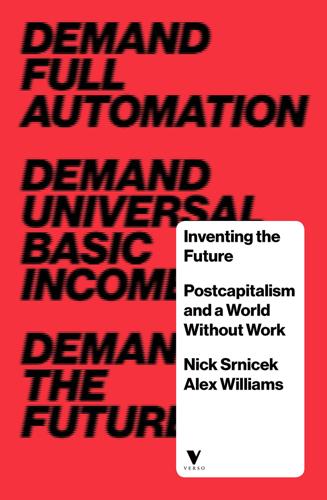
Inventing the Future: Postcapitalism and a World Without Work
by
Nick Srnicek
and
Alex Williams
Published 1 Oct 2015
Regardless of whether they had widespread solidarity, high levels of class consciousness or an optimal organisational form, they achieved success by being able to insert themselves into and against the flow of capitalist accumulation. In fact, the best predictor of worker militancy and successful class struggle may be the workers’ structural position in the economy. For example, within the early logistics infrastructure, dockworkers found themselves occupying a key point in the circulation of capital. Intermodal transport – the transferring of goods between ships, trains and trucks – was labour-intensive and costly.65 Lodged in a key passage through which goods had to circulate, the longshoremen who carried out the work controlled a major point of leverage. The result was that dockworkers were incredibly militant and lost more work days to labour disputes than almost any other industry.66 The famed strength of unions like the United Automobile Workers also arose from their structural position in the production process and the importance of the car industry to the national economy.
…
Strikes at these points, such as in the Pou Chen Group in China, pose a real threat to capitalist interests by blocking off an entire supply chain.69 At the other end of that chain, retail distribution is also primed for significant militant action, providing rich opportunities for the disruption of contemporary capitalism’s reliance on just-in-time logistics.70 The significance of such points of leverage can hardly be overestimated. But the past century has seen the conscious and unconscious winnowing away of these points of leverage. The development of shipping containers enabled the automation of intermodal transport;71 the globalisation of logistics facilitated capital’s ability to move factories in response to strikes; and the shift to oil as the primary energy source drastically reduced the number of choke-points available for political action. Today, the classic points of leverage have largely disappeared, necessitating a new round of experimentation and strategic reflection.
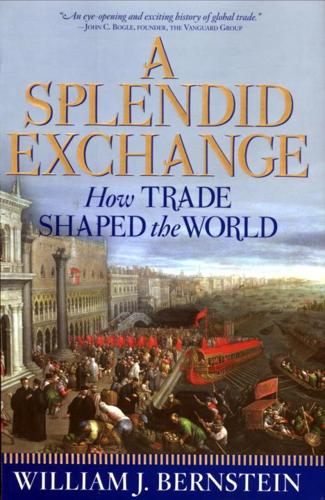
A Splendid Exchange: How Trade Shaped the World
by
William J. Bernstein
Published 5 May 2009
The power to regulate commerce among the states eventually gave rise in 1887 to the Interstate Commerce Commission (ICC), which regulated nearly every aspect of long-range transport in the United States, corroded nearly every industry it touched, and stifled American transport innovation until it was finally abolished in 1995. For more than a century, merchants had sought an "intermodal" shipping device that could be seamlessly loaded and unloaded among train, truck, and ship. In 1837 a shipper in Pittsburgh, James O'Connor, devised a boxcar that could be either fitted with train wheels or mounted on a canal barge, and in 1926 the Chicago North Shore and Milwaukee Railway began to "piggyback" trailers onto flatcars. The ICC decided that such intermodal devices fell under its authority and promptly brought their development to a halt. In the mid-1950s, two events revolutionized the technology.
…
The first was the brainchild of a visionary trucking executive, Malcolm McLean: a prototype of the modern shipping container, specifically designed to stack inside a surplus military tanker, chosen because of its relatively rectangular hull. The second was a federal court ruling in 1956 that removed intermodal containers from the ICC's purview. The widespread adoption of McLean's new system saw port costs plummet over the next few decades. If international freight had been cheap before 1960, afterward it became practically free-in the unlovely jargon of economics, "frictionless."49 Freed of burdensome tariffs and shipping costs, goods began circulating more freely around the globe.
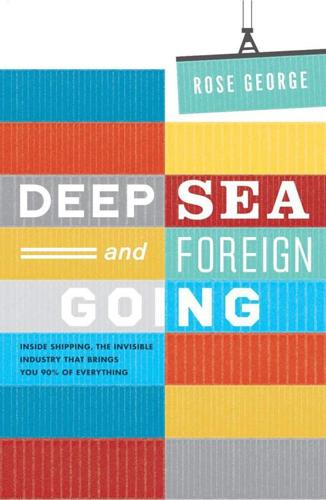
Deep Sea and Foreign Going
by
Rose George
Published 4 Sep 2013
In the nineteenth century coal was transported in wooden boxes on canal barges. McLean’s spark was to call on an engineer, Keith Tantlinger, to create a new design that could be seamlessly stacked and locked, using twist-locks. This new box could fit trains, trucks, cranes and ships alike. This ‘intermodality’ made perfect commercial sense, and labour unions hated it. Dockers in particular were furious. McLean claimed his box system reduced labour by two-thirds, reducing dockworkers’ workload, salary and power. This labour force could be powerfully obstructive when it chose, often instigating strikes that became national.
…
New ports had to be built: New York’s maritime wharfs – too shallow, too narrow – became useless, and the massive Greater Port of New York–New Jersey was constructed instead. The rewards of containerization were too great for the dockers to defeat change. Before containers, transport costs ate up to 25 per cent of the value of whatever was being shipped. With the extreme efficiencies that intermodality brought, costs were reduced to a pittance. A sweater can now travel 3000 miles for 2.5 cents; it costs a cent to send a can of beer. In hard economic times, when there is more supply than demand, shipping a container can cost nothing. By his junior officer days, the captain was in favour of boxes.

Spain
by
Lonely Planet Publications
and
Damien Simonis
Published 14 May 1997
The major ‘T-junction’ of the modern city is south of the old town at Plaza de España. The Estación Intermodal Delicias train and bus stations are about 2km west of the old centre. Return to beginning of chapter INFORMATION Self-promotion is a Zaragoza speciality if the number of tourist offices is anything to go by. Only the most useful are listed in this section. Conecta-T (976 20 59 79; Murallas Romanas 4; per hr €1.60; 10am-11pm Mon-Fri, 11am-11pm Sat & Sun) A well-organised facility with cheap international calls, mobile charge point and faxing. There’s another branch (Paseo Calanda 27) close to the train and bus stations. Estación Intermodal Delicias (976 32 44 68; 9am-9pm Easter-Oct, 9am-8pm Nov-Easter) Tourist office, in the train station.
…
Bus Dozens of bus lines fan out across Spain from the bus station attached to the Estación Intermodal Delicias train station. The more-useful companies include: Alosa (976 22 93 43; www.alosa.es in Spanish) At least eight buses to/from Huesca (€6.05, one hour), half of which continue to Jaca (€12.60, 2¼ hours). ALSA (902 42 22 42; www.alsa.es) Frequent daily buses to/from Madrid (€14, 3¾ hours) and Barcelona (€13.50, 3¾ hours). Train Zaragoza’s futuristic if rather impersonal Estación Intermodal Delicias (Calle Rioja 33) hosts a helpful tourist office. Zaragoza is connected by almost hourly high-speed AVE services to Madrid (€50.90, 1½ hours, approximately 10 daily) and Barcelona (€58.90, one hour).
…
In mid-July the Monegros Desert Festival (www.monegrosfestival.com), formerly called the Groove Parade, attracts dozens of Spanish and internationally renowned DJs and bands, who draw massive crowds at the event to Finca Les Peñetes, about 18km west of Fraga. * * * Bus 51 to/from Estación Intermodal Delicias begins/ends at Paseo de la Constitución, one block from Plaza de Aragón. Return to beginning of chapter SOUTH OF ZARAGOZA The A23 south towards Teruel passes through Campo de Cariñena, one of Aragón’s premier wine-producing regions. Just off the motorway, the Ermita de la Fuente in Muel has some fine paintings of saints by the young Goya.
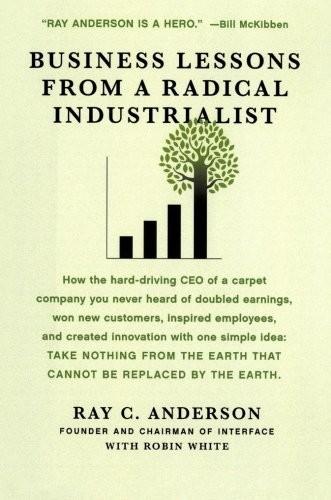
Business Lessons From a Radical Industrialist
by
Ray C. Anderson
Published 28 Mar 2011
Lina Marshall, one of our yarn preparation associates in my hometown of West Point, wondered out loud why we were buying Cool Fuel (gasoline with an added green tax) to offset the travel of our sales force but not for that of our plant workers? These offsets went to build wind farms, finance a major trucking company’s transition from all trucks to intermodal (trucks plus rail) operations, even to pioneer CO2 sequestration in oil fields. Lina asked a good question, and it set off a chain of events that resulted in our Cool CO2mmute Program. In it we split the cost with our associates to plant trees that offset the CO2 emissions produced by their daily commutes to and from work.
…
Maybe it’s a bit complicated, but we offset tons of CO2 as we burn gallons of gas. Using the rebate from fuel purchases, Interface buys CO2 credits from a variety of sources to offset these emissions. The credits come from a blended portfolio of social and environmental projects, including projects for renewable energy, carbon sequestration, intermodal transport, and climate-neutral product manufacturing in other industries. Cool CO2mmute was designed as a way for every associate, no matter where they work, to “walk the talk” on our journey up Mount Sustainability and to show others the way. Launched in 2002, Cool CO2mmute opened up the same possibilities of offsetting car travel for all Interface associates.
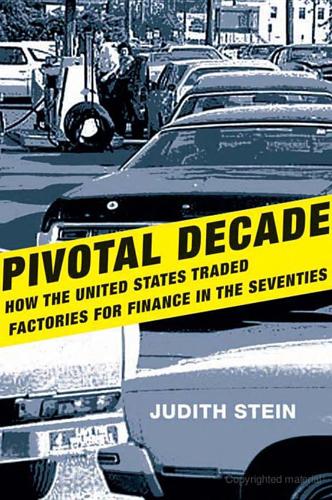
Pivotal Decade: How the United States Traded Factories for Finance in the Seventies
by
Judith Stein
Published 30 Apr 2010
He had opposed the new Department of Education that Carter proposed and had his own ideas about national health insurance and much else. Blumenthal posed other problems. He liked the limelight and claimed that he was the architect of economic policy. Adams was forced out because he was not a supporter of transportation deregulation. He preferred intermodal transportation planning. Schlesinger and Attorney General Griffin B. Bell had indicated that they wanted to leave, but Carter included them with the men who were fired. Carter then made his thirty-four-year-old aide, Hamilton Jordan, White House chief of staff. Not only did the energy story take a backseat to the political story, which was a lot more appealing and comprehensible to reporters, but the public could wonder about the soundness of an energy plan which was put together by men who were then fired.40 Nevertheless, the Congress embraced the energy program, approving the Energy Security Corporation in June 1980.
…
He believed that the ICC’s pricing regulations were outmoded, that the separation of trucking, railroad, maritime, and airline regulations was inefficient, but that new government power could plan for the future of the U.S. economy. Richard Nixon, too, tried to create superagencies to facilitate a more coherent transportation system. Carter’s first secretary of transportation, Brock Adams, renewed ideas of intermodal planning. Carter, who fired Adams in July 1979, opted instead for what he called a “free enterprise” solution. Mark H. Rose, Bruce E. Seely, and Paul F. Barrett, The Best Transportation System in the World (Columbus: Ohio State University, 2006), 137, 195–211. 125. Alan Brinkley, End of Reform: New Deal Liberalism in Recession and War (New York: Alfred A.
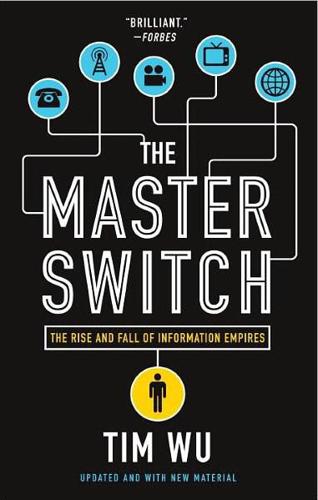
The Master Switch: The Rise and Fall of Information Empires
by
Tim Wu
Published 2 Nov 2010
In the next few years, one after another of the Bells’ would-be rivals withered and died, and all the while Bell representatives murmured about the challenges of surviving in a competitive industry. Indeed, the only companies that would manage to survive as challengers in telephony were the cable firms, who had wires of their own running into every home, and whom the Act of 1996 had freed to become an intermodal competitor, the only kind the Bells couldn’t destroy. Nevertheless, within a decade after the Telecommunications Act of 1996, history had repeated itself, and the Bells once again ruled the telephone system unperturbed. The idea of inducing “fierce” competition over Bell’s proprietary wires, like the fledgling companies that had taken the bait, was utterly dead.
…
In an age more reliant than ever on telecommunications media, the more concentrated the power over information and communications, the easier it is for government to indulge its temptation to play Big Brother. With everyone in the country now connected, the fewer the parties that need to be persuaded to cooperate, the greater the risk. With the convergence of all communications by virtue of interconnected networks (aka intermodality), the reconstituted giants of telephony are closer to possessing a master switch than Vail himself could have dreamed. Those are the unremarked costs of the return of the empire. THE CYCLE By 2007, Ed Whitacre had fulfilled his mission, and his destiny. Most of the Bell system was back in place in the world’s largest communications firm, with him at the helm.
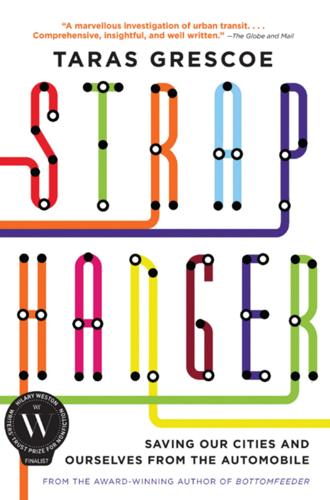
Straphanger
by
Taras Grescoe
Published 8 Sep 2011
Commuter and intercity rail is good at moving people along major corridors, but it fails to get them the final few blocks to their homes or offices. Thanks to Copenhagen’s good bicycle infrastructure, the last-mile problem is a virtual non-issue. People just hop on a bike. Danes, in fact, seem to have an instinctive knack for hybrid and intermodal transportation. By law, all taxis in Denmark are required to have a rack for carrying two bicycles. A single, transferable transit pass allows Copenhageners to ride buses, the Metro, and mini-ferries across the harbor. Commuters who ride the Metro or S-train downtown often own two bikes, a utilitarian model they lock outside Central Station and use to get to work, and a fancier one for riding to their home in the suburbs.
…
So many Copenhageners already own their own bicycles that City Bikes are mostly used by tourists and business travelers, but systems like Paris’s Vélib’ have transformed a significant number of Parisians into enthusiastic cyclists. For cycle advocates, bike-share systems function like Trojan horses in car-besieged cities. At minimum expense, they introduce people to an alternative to driving. In many cities, including my hometown of Montreal, stands are located next to subway or métro stations, allowing for true intermodal transportation. Lately, I get a lot of satisfaction in maneuvering my borrowed bike into an unoccupied dock with a resounding thwack, before heading straight for the métro turnstiles. Taming the Bull I’d arranged to meet Mikael Colville-Andersen outside my hotel in the district of Vesterbro.

Atlantic: Great Sea Battles, Heroic Discoveries, Titanic Storms & a Vast Ocean of a Million Stories
by
Simon Winchester
Published 27 Oct 2009
They could then be shipped to a faraway port and, without once having been opened or tinkered with or touched by interfering human hand, could be unloaded and placed on another set of trucks or railroad flatcars and taken off to the distant destination. This was the birth of what was to be called intermodal shipping, whereby a floating vessel—a ship—became just one part of a long chain of types of transport that with brutal efficiency and economy would henceforward move products from all points in the world to all others. It was a development that may have reduced costs and enhanced efficiency—but at a stroke it also stripped ocean trading of all its remaining romance and allure.
…
H., 135 Hydrography, 99–104, 120 Iapetus Ocean, 39, 42 Icebergs, 409–10 Iceland, 46, 158–59, 273–75, 343, 410, 437 Icesheets and ice caps, 395–402, 405–6, 408–12 Iguazu Falls, 47 Ilhéu das Rôlas, 145 Immigrant (term), 317n Immigration, 13, 177, 316–21 Impressionism, 196 Incas, 162 Indian Ocean, 34, 107, 146, 409, 423n, 433–34, 439–40 Indies, 86–87, 216–17 Ingstad, Helge, 80–82 In Hazard (book), 205 Inishtrahull Island, 7–8 Institute for Atmospheric Physics, 348n Institutions, oceanographic, 140–45 Insurance, 235, 322, 436 Intergovernmental Panel on Climate Change, 404–5 Intermodal shipping, 350–52. See also Cargo shipping International Atomic Energy Agency, 356 International Hydrographic Organization, 100–104, 142–43, 409 International laws. See Laws International trade. See Trade Introversion, 443 Ireland, 71–73, 90–91, 153–54, 337–38 Ireland’s teardrop, 5, 6 f Irish Sea, 7, 357 Iron battleships, 252–55 Ironclad ships, 247–51 Iron curtain speech, 278n Isla de Los Estados, 128, 444–47 Islam, 215–16 Islands formation of, 46–47 phantom, 134 Islas Malvinas, 210.
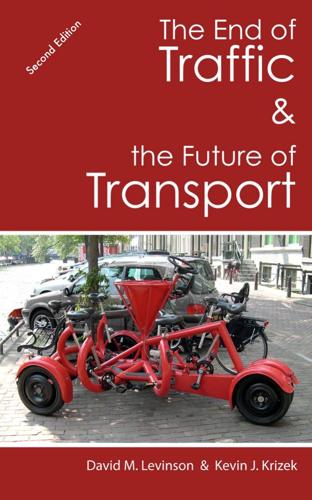
The End of Traffic and the Future of Transport: Second Edition
by
David Levinson
and
Kevin Krizek
Published 17 Aug 2015
Proclaimed as largest public works project in the world since the Pyramids, there are good reasons the Interstate Highway Act left many legacies.7 An often unrealized impact, however, is that for the next half-century, transport centered on the themes of deployment (rolling out the highway network), and management (better operating the system). Transport planning in the Interstate Era focused on more roads here, removing bottlenecks there, better managing capacity over yonder. Innovation (technological or policy), took a back seat. So did doing anything exciting. The 1992 Highway Bill, more formally the Intermodal Surface Transportation Efficiency Act (refreshingly nicknamed ISTEA (Ice Tea)), mildly deflected the highway-centric trajectory of US transport investments. Reducing the negative externalities attributed to auto use received increased attention; other modes received a boost of funding and acknowledgement.
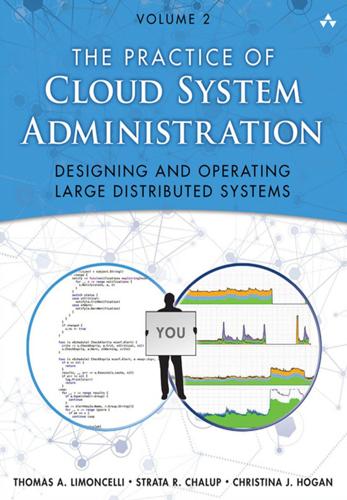
The Practice of Cloud System Administration: DevOps and SRE Practices for Web Services, Volume 2
by
Thomas A. Limoncelli
,
Strata R. Chalup
and
Christina J. Hogan
Published 27 Aug 2014
A single container might hold many individual items, but since they were transported as a group, transferring the items between modes of transport was quick work. Customs could approve all the items in a particular container and seal it, eliminating the need for customs checks at remaining hops on the container’s journey as long as the seal remained unbroken. As other modes of transportation adopted the standard shipping container, the concept of intermodal shipping was born. A container would be loaded at a factory and remain as a unit whether it was on a truck, train, or ship. All of this started in April 1956, when Malcom McLean’s company SeaLand organized the first shipment using standardized containers from New Jersey (where Tom lives) to Texas.
…
continuous delivery, 190, 223 DevOps Cafe Podcast, 188, 200 HVMs (hardware virtual machines), 58 Hybrid load balancing strategy, 75 Hyper-Text Transfer Protocol (HTTP) load balancing, 75 overview, 69 IaaS (Infrastructure as a Service), 51–54 IAPs (Incident Action Plans), 326–327 Ideals for KPIs, 390 Image method of OS installation, 219–220 Impact focus for feature requests, 46 Implementation of disaster preparedness, 318–320 Import controls, 41–42 Improvement levels in operational excellence, 412–413 Improving models in design for operations, 48–49 In-house service provider factor in service platform selection, 67 Incident Action Plans (IAPs), 326–327 “Incident Command for IT: What We Can Learn from the Fire Department” talk, 323 Incident Command System, 323–324 best practices, 327–328 example use, 328–329 Incident Action Plan, 326–327 IT operations arena, 326 public safety arena, 325 Incident Commanders, 324–325, 328 Index lookup speed, 28 Individual training for disaster preparedness, 311–312 Informal review workflows, 280 Infrastructure automation strategies, 217–220 DevOps, 185 service platform selection, 67 Infrastructure as a Service (IaaS), 51–54 Infrastructure as code, 221–222 Inhibiting alert messages, 356–357 Initial level in CMM, 405 Innovating, 148 Input/output (I/O) overload, 13 virtual environments, 58–59 Installation in deployment phase, 212–213 OS and services, 219–220 Integration in DevOps, 182 Intel OKR system, 389 Intentional delays in continuous deployment, 238 Intermodal shipping, 62 Internal backbones in cloud-scale service, 83–85 Internet Protocol (IP) addresses deployment phase, 222 load balancers, 72–73 restrictions on, 40 Introducing new features, flag flips for, 232 Introspection, 10 Invalidation of cache entry, 108 Involvement in DevOps, 183 IP (Internet Protocol) addresses deployment phase, 222 load balancers, 72–73 restrictions on, 40 Isolation in ACID term, 24 ISPs for cloud-scale service, 83 Issues naming standards, 264 tracking systems, 263–265 IT operations arena in Incident Command System, 326 ITIL recommended reading, 488 j-SOX requirements, 43 Jacob, Adam, 173 Jails containers, 60 processes, 55 Java counters, 350 JCS (joint cognitive system), 248 Jenkins CI tool, 205 Job satisfaction in service delivery, 201 Joint cognitive system (JCS), 248 JSON transmitted over HTTP, 351 Kamp, P.
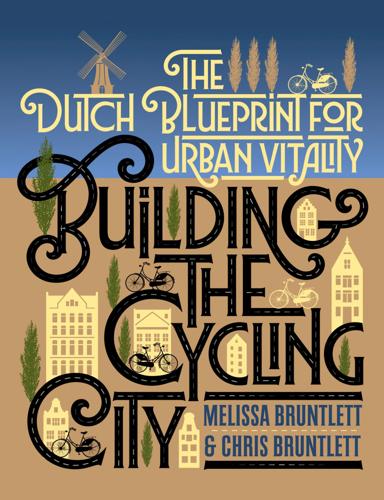
Building the Cycling City: The Dutch Blueprint for Urban Vitality
by
Melissa Bruntlett
and
Chris Bruntlett
Published 27 Aug 2018
I think the main reason people in the Netherlands use OV-Fiets is that it’s a great concept for your “last-mile” journey: it’s fast, flexible, healthy, and it gives you a sense of freedom in a city other than your hometown.” Replicating the Dutch BiTiBi Model There’s no doubt that the Dutch desire to promote bike–train intermodality over private car use is garnering a great deal of international attention. The growing number of organizations examining their system in further detail, in an attempt to reproduce it and address typical gaps and problem areas, is a clear demonstration of this awareness. Perhaps the most ambitious of these studies is the European BiTiBi (“Bike-Train-Bike”) Project—funded by the European Union’s Intelligent Energy Programme and 10 partners in five different countries.
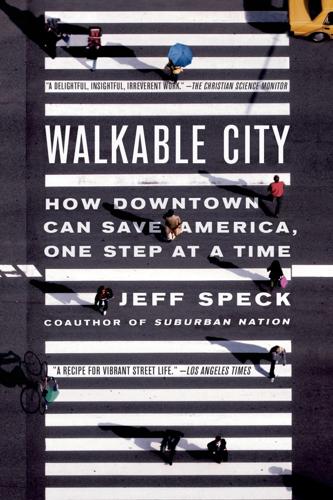
Walkable City: How Downtown Can Save America, One Step at a Time
by
Jeff Speck
Published 13 Nov 2012
●This paragraph and the next restate one of the principal arguments to be found in Andres Duany, Elizabeth Plater-Zyberk, and Jeff Speck’s Suburban Nation, where the discussion is made in much greater detail. ●Park-and-ride thrives only in cities where driving downtown is prohibitively expensive in terms of money or time, since people who begin their commutes in a car are loath to make the dreaded intermodal shift unless punishment awaits (Duany, Plater-Zyberk, and Speck, Suburban Nation, 138–39). ●No quick Shoupista pricing fix here: Dallas is so overpaved that its super-cheap parking—typically a dollar per hour—is actually the free-market rate. ■This conclusion was supported by the study “The Fundamental Law of Road Congestion: Evidence from U.S.
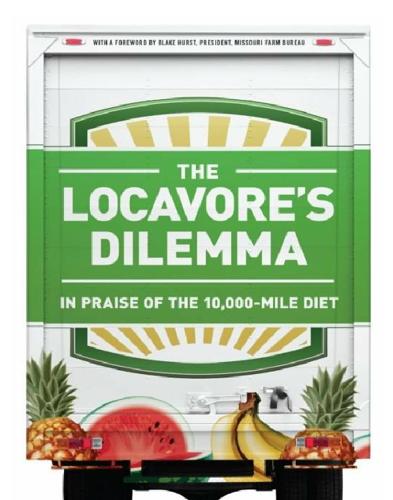
The Locavore's Dilemma
by
Pierre Desrochers
and
Hiroko Shimizu
Published 29 May 2012
In the Ancient Mediterranean era, these included grain, wine, olive oil, fish sauce and paste, salt, and, to a lesser extent, honey, and spices (some of which came from as far away as India and China). Over time, the development of ever better means of transportation (improved sailing ships, canals, and barges; coal, gasoline, diesel, residual fuel oil and kerosene-powered rail locomotives, boats, ships, trucks, and cargo planes; and intermodal shipping containers) and improvements in old ways of preserving food and the development of new ones (from fermenting, drying, smoking, salting, and pickling to canning, juicing, chilling, freezing, and irradiation) provided urban consumers first—and rural consumers later—an ever broader range of commodities that had traveled over long distances, from pickled herrings, salted and dried cods, sugar, coffee, tea, and cocoa to canned fruits, frozen meat and eventually fresh produce, meat, fish, seafood, dairy products, and eggs.18 Apart from increased diversity and volume of supply, advances in transportation also equalized prices between locations.
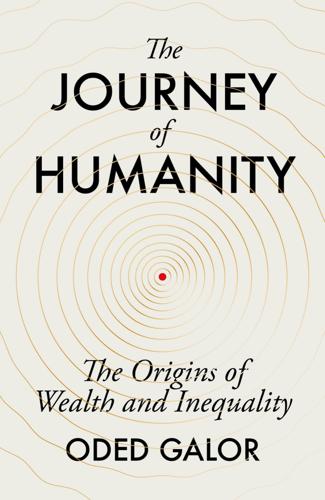
The Journey of Humanity: The Origins of Wealth and Inequality
by
Oded Galor
Published 22 Mar 2022
Thanks to them, Mexico became self-sufficient in grain in the 1960s, while India and Pakistan almost doubled their wheat harvests over the years 1965–70 and became self-sufficient in cereal production in 1974. In many other cases, innovation was primarily organisational rather than technological or scientific. In 1968, the International Organization for Standardization recommended American entrepreneur Malcolm McLean’s design for the modern intermodal shipping container as the standard template worldwide. The adoption of this uniform design across all modes of transportation made loading and unloading at ports significantly more efficient, dramatically reducing the costs of freight transport and contributing to a boom in international trade.

Quarantine
by
Greg Egan
Published 13 Dec 1994
Neurons that are already part of existing mods are tagged with cell-surface proteins which no correctly functioning nanomachine could miss—and are also altered in other ways which would need to be deliberately reversed before they could be stimulated into changing their synaptic connections. Lui gave me no name to invoke, so I have MindTools (Axon, $249) perform an inventory; it can’t ‘scan’ my whole skull by any means, but it can send a standard ‘announce yourself’ request down the inter-mod neural bus, and list the replies it gets back. Only the loyalty mod remains silent, refusing to name itself, or even to admit its presence. The collapse-inhibiting mod turns out to be camouflaged, hidden inside a cheap-and-nasty games mod called Hypernova (Virtual Arcade, $99). Hypernova is to von Neumann what, in my childhood, a dedicated games machine was to a personal computer.

The Dawn of Eurasia: On the Trail of the New World Order
by
Bruno Macaes
Published 25 Jan 2018
If containers are transported to their final destination in Europe or Central Asia and China via rail transport, they are transferred to and from the ship directly and use the terminal in the new Alyat port rather than the old terminal in Baku. With the conclusion of the first phase of the port’s expansion over the next couple of years, all intermodal operations will be done here. Alyat is well placed to become the largest and most modern port in the Caspian. Going through immigration control was surprisingly easy, so we were fully installed in our cabins with some time to spare before departure. These are the most barren cabins you can imagine: a bunk bed, an old mattress, no blankets.

Driverless: Intelligent Cars and the Road Ahead
by
Hod Lipson
and
Melba Kurman
Published 22 Sep 2016
As a full-fledged federal program, ITS was responsible for the research and development of all modes of automated surface transportation, including automated traffic-management systems, driver-information systems, commercial vehicles, and public transportation. That same year, to add fuel to the fire, Congress passed a major new transportation bill, the Intermodal Surface Transportation Efficiency Act (ISTEA). The act decreed that the secretary of transportation “shall develop an automated highway and vehicle prototype from which future fully automated vehicle-highway systems can be developed. … The goal of this program is to have the first fully automated roadway or an automated test track in operation by 1997.”4 The USDOT placed responsibility for executing this lofty goal inside the Federal Highway Administration.
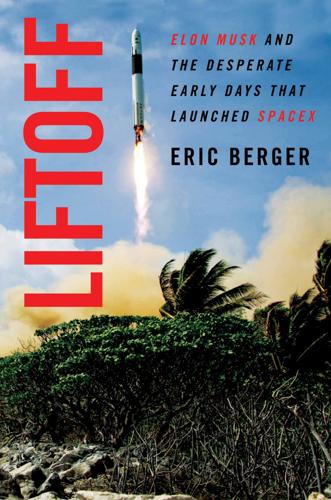
Liftoff: Elon Musk and the Desperate Early Days That Launched SpaceX
by
Eric Berger
Published 2 Mar 2021
Amid a search for creative solutions, Buzza thought he had solved this problem by finding a machine advertised as capable of condensing air and separating liquid oxygen. Musk even signed off on the purchase order. Phil Kassouf, the avionics engineer, remembers the machine arriving on Omelek in an unexpectedly huge package. Fully assembled, it measured about half the size of a standard intermodal shipping container. “It looked like it had come out of a mad scientist’s laboratory, all spinning and whirring, with valves and gauges,” he said. The engineers and technicians spent days greasing the machine, oiling it, lubing it, before finally turning it on. It belched. It made noise. And when the curious engineers returned after about forty-five minutes, Buzza exclaimed excitedly that the machine was working.
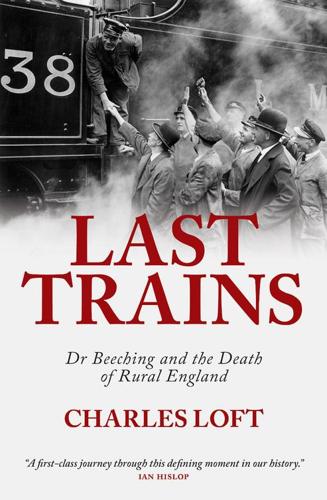
Last Trains: Dr Beeching and the Death of Rural England
by
Charles Loft
Published 27 Mar 2013
A small body whose members were generally past the peak of their professional abilities, it oversaw a vast undertaking, the structure of which, divided into executives responsible for railways, docks and waterways, hotels, London Transport, road haulage and buses, was hardly conducive to either inter-modal coordination or central direction. In particular the Railway Executive, which accounted for around 80 per cent of the business, was eager to go its own way. Establishing the new organisation was a complicated process and by 1951 the Commission had yet to complete the acquisition of road haulage companies.
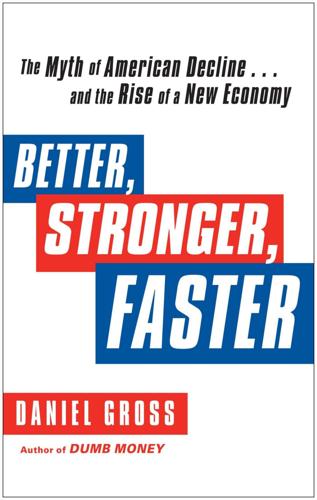
Better, Stronger, Faster: The Myth of American Decline . . . And the Rise of a New Economy
by
Daniel Gross
Published 7 May 2012
The new economy of online retailing and e-commerce, rising exports, and more tourism, goods, services, and people whizzing around the world, which has already done so much to spur growth, demands better infrastructure of all types. The Panama Canal is undergoing a $5.25 billion widening and expansion program that will allow for the passage of larger ships. That means U.S. ports will have to be upgraded. If the volume of trade continues to rise, if exports are to double, then rail, trucking, intermodal, and shipping infrastructure will have to expand as well. To attract and handle more tourists, American airports need a facelift and major internal surgery; they have to become as efficient as their counterparts overseas. These are signs that the United States is falling behind, especially when countries such as China are making splashy, highly visible infrastructure investment.
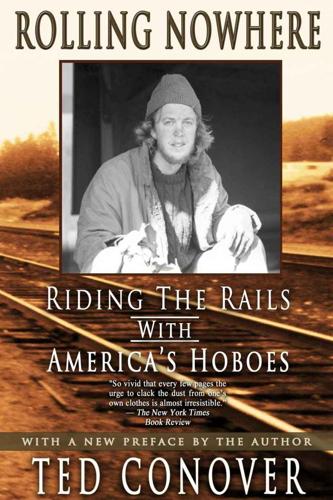
Rolling Nowhere
by
Ted Conover
Published 14 Jun 1984
When I took my journey, there were still plenty of wooden- floored boxcars, the classic hobo roost. Now these boxcars are all but gone (along with cabooses, whose occupants used to alert the engine crew of wheel trouble or inform them when the end of the train was finally off the main track—jobs now performed by electronic sensors). More and more freight is “intermodal”: container boxes go straight from ships to the new “stack” and “doublestack” freight cars, truck trailers are lifted onto piggyback freight cars and unloaded again on the other side of the country. A guy can still catch a ride on those freight cars, but he’s more exposed to weather and scrutiny and the rides are less comfortable.
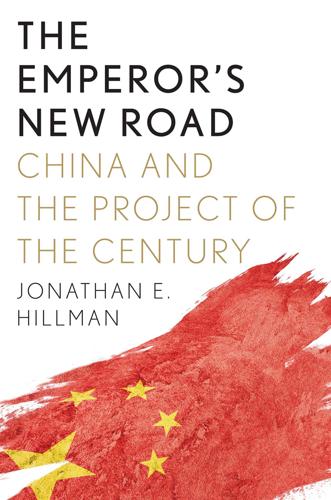
The Emperor's New Road: How China's New Silk Road Is Remaking the World
by
Jonathan Hillman
Published 28 Sep 2020
Evgeny Vinokurov, “Eurasian Economic Union: Current State and Preliminary Results,” Russian Journal of Economics 3, no. 1 (March 2017): 54–70, http://www.sciencedirect.com/science/article/pii/S2405473917300041#bib0085. 38. Ministry of Transport of the Russian Federation, “Railway Checkpoints,” https://www.rosgranstroy.ru/checkpoints/list.php?bitrix_include_areas=Y&SECTION_ID=188. 39. Gordon Graham, “Cross-Border Intermodal,” Canadian National Railway Company, http://www.theccib.com/files/4_CN_CrossBorder_GordonGraham.pdf. 40. Henry Sanderson, “Jay Hambro: Bridge to a Future in Russia,” Financial Times, January 26, 2016, https://www.ft.com/content/033a2f7a-b955-11e5-bf7e-8a339b6f2164. 41. Wei He, “Program of Cooperation between the Regions of the Far East Siberia of the Russian Federation and the Northeast of the Chinese People’s Republic (2009–2018)” (in Russian), Xin Da Li, May 3, 2010, http://www.chinaruslaw.com/RU/CnRuTreaty/004/201035210624_735729.htm. 42.
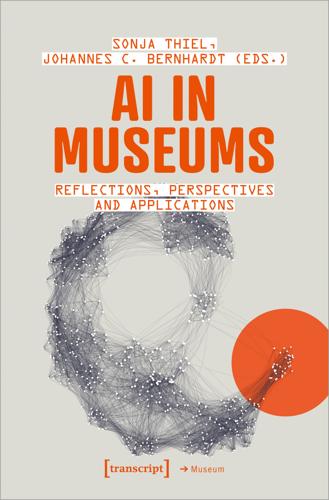
AI in Museums: Reflections, Perspectives and Applications
by
Sonja Thiel
and
Johannes C. Bernhardt
Published 31 Dec 2023
As can easily be seen by tinkering around with models like Stable Diffusion or in experiments accessible on the Internet, many surprises lurk here, and the addition of even one or more phrase points at the end of a text prompt, which may be rather meaningless for us, can significantly affect the output.10 In order to actually use such a model or tool productively, some practical experience on the part of the human user is thus definitely required. In addition, even with a more intuitive input/output behaviour, any use of such tools requires some kind of intermodal translation from text to image: one paints and draws with words, as it were, which would 9 10 I am unable to address this argument in detail here for reasons of space. But the approach of relating culture to its tools and technologies and simultaneously considering the latter within the context of cultural conditions and purposes has a long and varied tradition, which can be linked, for example, to the history of technology and the journal Technology and Culture or to the popular account by Arnold Pacey (1983), which includes institutional and organizational points of view.
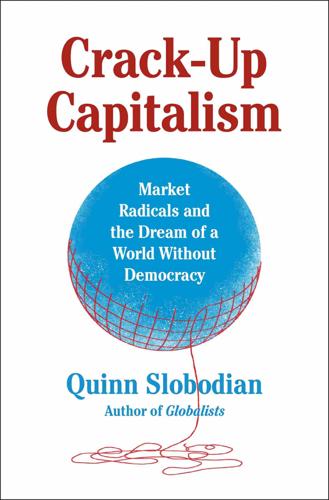
Crack-Up Capitalism: Market Radicals and the Dream of a World Without Democracy
by
Quinn Slobodian
Published 4 Apr 2023
In November 2008, DP World requested a suspension of repayments on its loans, and Dubai itself needed to be bailed out by Abu Dhabi.82 Jafza pulled out of Orangeburg. The Trump Tower Dubai planned for the trunk of the Palm Jumeirah was not built. 4. Dubai was a new kind of state, tailor-made for globalization. Deregulation of shipping and trucking allowed for intermodal transport that supercharged maritime trade. Technical innovations in gantry cranes made it faster than ever to get ships loaded and unloaded. Wide-body long-haul aircraft allowed for a place distant from most business centers to become a key node in the global network—an “aerotropolis,” as a journalist dubbed it.83 (One textbook observed that nearly any two places in the world could be linked by a stopover in Dubai.)84 The end of capital controls and the fluidity of money turned the emirate’s gleaming towers and villas into three-dimensional tax-free savings accounts.
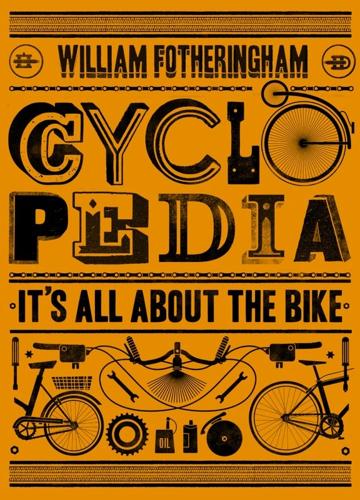
Cyclopedia
by
William Fotheringham
Published 22 Sep 2011
ENVIRONMENT Cycling is now a recognized means of lowering one’s carbon footprint. The figures speak for themselves—100 calories takes a cyclist 3 miles, a car all of 280 feet. In 2009 research indicated that if cycling use in cities doubles from 4 percent of journeys to 8 percent, there would be a total drop of 1.1 percent in carbon emissions. If those journeys are intermodal (public transport + bike), the figure can go up to 1.8 percent because greater distances can be covered. On the other hand, cycling as a pastime rather than a means of transport is by no means carbon friendly. Driving from London to the south of France with a bike on the roofrack creates 360 kgm of CO2; taking the train and hiring a bike creates 100 kgm; flying with the bike in the hold creates 850 kgm, more than heating the average house for a year.

Age of Discovery: Navigating the Risks and Rewards of Our New Renaissance
by
Ian Goldin
and
Chris Kutarna
Published 23 May 2016
The walls that divided “us” from “them” in the Cold War era meant that global exports of physical goods (measured as a share of global gross domestic product, GDP) were no higher in 1973 (12 percent) than they had been in 1913 before the outbreak of World War I.6 No higher, despite the many big, new catalysts of cross-border trade introduced in those intervening 60 years, including the invention of wide-body passenger and cargo jets and a commercial airline industry, intermodal container shipping, mass domestic and international telephony, an international gold standard to eliminate exchange rate risk from international money movements and the multinational corporation. Once the walls came down, the flow of merchandise became a cascade—far greater in volume and variety than during the previous half-century, and mutually reinforcing as new markets and production centers connected into the global economy.
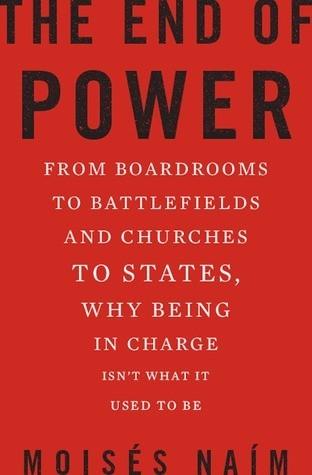
The End of Power: From Boardrooms to Battlefields and Churches to States, Why Being in Charge Isn’t What It Used to Be
by
Moises Naim
Published 5 Mar 2013
In most countries, access to capital is no longer the insurmountable barrier to the creation or expansion of a new company as it once was. The ramifications are nearly endless, ranging from staffing requirements to insurance costs to the ability to move operations from site to site quickly. Containerization has streamlined shipping and allowed efficient, reliable intermodal transportation of goods of all kinds. In 2010, the volume of container traffic was more than ten times that in 1980.25 Almost all of the technologies that we either see in museums (the steam engine) or take for granted (the radio) represented a disruption in their time. But today’s technological revolution is unequalled in scope, touching almost every human activity in the world at dizzying speed.

An Extraordinary Time: The End of the Postwar Boom and the Return of the Ordinary Economy
by
Marc Levinson
Published 31 Jul 2016
In the 1960s, a trade agreement between Canada and the United States had made it practical for auto parts manufacturers on one side of the border to supply assembly plants on the other, and a handful of Japanese electronics companies fought rising labor costs at home by having circuit boards soldered in Hong Kong. But it was only the spread of intermodal transportation and cheap communications that made it practical for manufacturers and retailers to stretch their supply chains across the oceans and for financial and transportation companies to send routine data-entry work abroad. There were many kinks to work out. Globalization came with a learning curve, and the learning often entailed a considerable loss of productive efficiency.12 The greatest beneficiaries of globalization were the fast-growing “tiger” economies of East Asia.
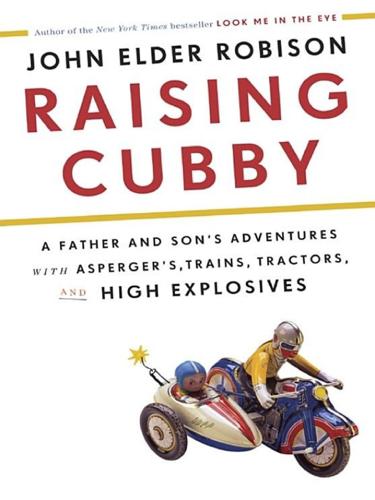
Raising Cubby: A Father and Son's Adventures With Asperger's, Trains, Tractors, and High Explosives
by
John Elder Robison
Published 12 Mar 2013
As Cubby chewed, he followed us on a memorable and detailed tour of the trains, tracks, and supporting machinery. We particularly enjoyed seeing the loading and unloading facilities, especially the container cranes in action. Those articulated monsters took containers from the backs of trucks and set them onto special railcars. “We’re very proud of our new intermodal terminal,” he said, as we both nodded in agreement. Cubby enjoyed seeing the newest GE locomotives parked on a siding. As he observed, they were the same model as the ones in the annual report, but a little dirtier. Big engines like those passed through Springfield without stopping most days. These are neat, he said, with wonder and admiration.
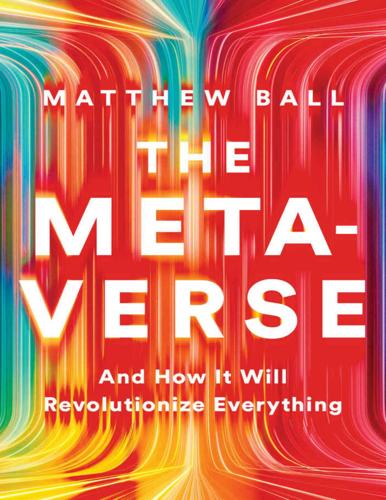
The Metaverse: And How It Will Revolutionize Everything
by
Matthew Ball
Published 18 Jul 2022
Crucially, 61% of respondents said they did not use their native language when working with foreign partners, thus the alignment on English was not a reflection of the fact most respondents were primarily English speakers.5 Globalization has also led to de facto standards in currencies (namely the US dollar and the Euro); units (e.g., the metric system); exchange (the intermodal shipping container); and so on. Crucially, as Omniverse showed, software does not need everyone to speak the same language. Instead, think of it as comparable to the system within the European Union, which has 24 official languages represented but three (English, French, German) “procedural” languages which are prioritized (also, much of the EU’s leadership, parliament, and staff can speak at least two of these languages).
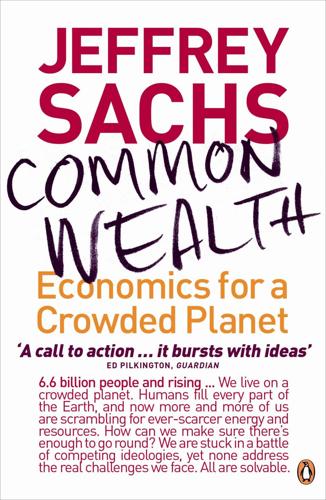
Common Wealth: Economics for a Crowded Planet
by
Jeffrey Sachs
Published 1 Jan 2008
At a low level of economic development, government responsibilities involve investing in basic infrastructure, especially roads, power, primary schools, clinics, and water and sanitation. At the next stage, the government must concern itself with highways, Internet connectivity, containerization, and intermodal transport (the interface of sea-, air-, and land-based freight). At a still later stage, the government must invest heavily in scientific capacity and higher education. At all stages of development, the government must also ensure that the basic conditions of a functioning market-based economy are in place.
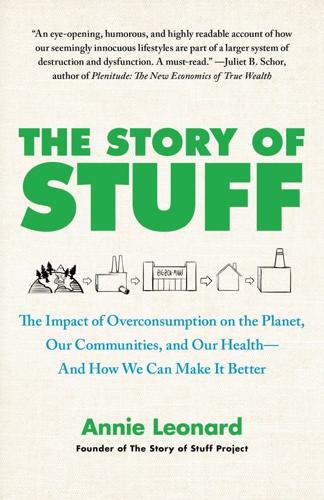
The Story of Stuff: The Impact of Overconsumption on the Planet, Our Communities, and Our Health-And How We Can Make It Better
by
Annie Leonard
Published 22 Feb 2011
“Large Cargo Ships Emit Double Amount of Soot Previously Estimated,” Science Daily, July 11, 2008 (sciencedaily.com/releases/2008/07 /080709103848.htm). 28. John W. Miller, “The Mega Containers Invade,” The Wall Street Journal, January 26, 2009 (online.wsj.com/article/SB123292489602813689.html). 29. America’s Freight Challenge, p. 13. 30. Freight and Intermodal Connectivity in China, a report sponsored by the U.S. Department of Transportation, Federal Highway Administration, May 2008, pp. 19–23 (international.fhwa.dot.gov/pubs/pl08020/pl08020.pdf). 31. Ibid., p. 23. 32. Ibid., p. 31. 33. America’s Freight Challenge, pp. 18–19. 34. Ibid., p. 19. 35.
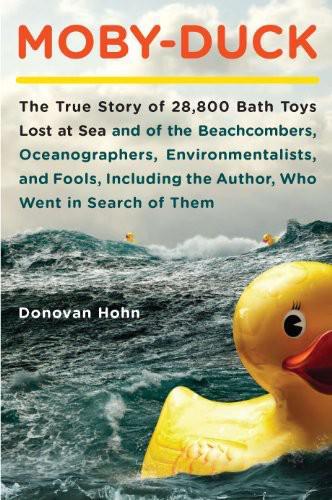
Moby-Duck: The True Story of 28,800 Bath Toys Lost at Sea and of the Beachcombers, Oceanographers, Environmentalists, and Fools, Including the Author, Who Went in Search of Them
by
Donovan Hohn
Published 1 Jan 2010
Spars and canvas have given way to seventy-thousand-horsepower engines that burn two hundred metric tons of fuel per day. Wooden hulls have given way to steel, the astrolabe and sextant to gyrocompasses and satellites. And yet, today’s cargo vessels also take riskier routes. When the trucking magnate Malcolm McLean perfected the humble intermodal shipping container in the early fifties, he revolutionized the stolid shipping industry. Containerization introduced efficiencies and economies of scale that made shipping fees plummet. The only way to make more money was to increase volume by making bigger vessels deliver more cargo faster. Hulls had to be enlarged—by 2006 they would exceed 1,300 feet in length, 340 feet longer than the QE2.

The Zero Marginal Cost Society: The Internet of Things, the Collaborative Commons, and the Eclipse of Capitalism
by
Jeremy Rifkin
Published 31 Mar 2014
The entire system, from warehousing to transport to end users, would need to operate by the same standard technical protocols to assure easy passage from one point to another. On the Logistics Internet, conventional point-to-point and hub-and-spoke transport would give way to distributed, multisegment, intermodal transport. Instead of one driver handling the entire load from the production center to the drop off and then heading to the nearest location to pick up a shipment designated for delivery on the way back home, the delivery would be distributed. The first driver might deliver the shipment to a hub close by and then pick up another trailer and shipment and head back home.
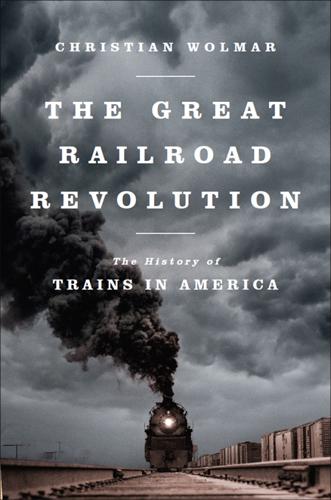
The Great Railroad Revolution
by
Christian Wolmar
Published 9 Jun 2014
It was fifty years too late, but was passed just in time to save the industry from collapse. At last, the railroads could set their own rates for carriage, which meant they could ensure that they were high enough to allow them to invest in improvements and earn their shareholders a reasonable rate of return. The carriage of coal, grain, cars, and intermodal containers—which could be used on both trucks and trains—grew rapidly, as the railroads were able to offer flexible and more attractive rates. The railroads were also allowed to close lines without seeking permission, which meant they could mothball unprofitable routes. The results were immediate.
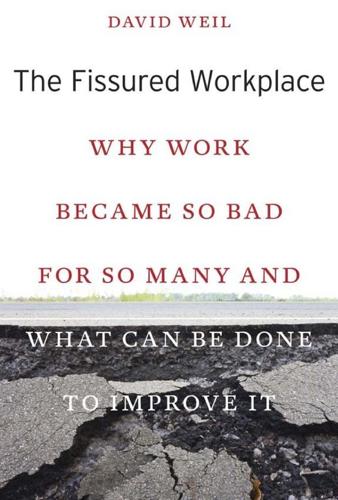
The Fissured Workplace
by
David Weil
Published 17 Feb 2014
This coincided with the adoption of similar technologies in retailing (by Walmart and others) to transform how those companies handled information and coordinated logistics.6 Schneider Logistics was launched in 1993 to focus on the rapidly growing business of handling the flow of products and materials in the manufacturing and retail sectors, winning a contract to provide General Motors with logistics support for its part suppliers in 1994.7 It used its access to its own network of trucks, trailers, and drivers, major intermodal facilities and equipment, and sophisticated communication systems. Its core competency, which makes it attractive to customers like Walmart, is its expertise in handling imported goods arriving in shipping containers from ports and processing those goods so that they can be efficiently shipped to retail stores.8 With the rapid growth in goods arriving from offshore in the 1990s, retailers like Walmart needed to find efficient means to process, transport from docks, and unload that stock from shipping containers used for ocean transportation, and then sort, record, repack, and load those goods for transportation to regional distribution centers or directly to stores.
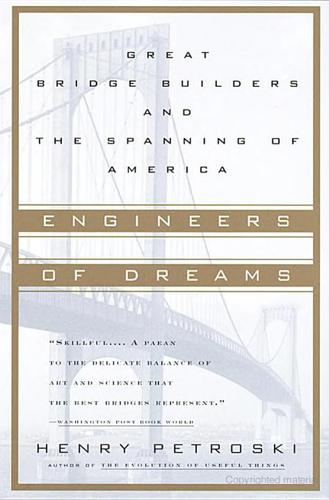
Engineers of Dreams: Great Bridge Builders and the Spanning of America
by
Henry Petroski
Published 2 Jan 1995
It has been estimated that as much as 2 percent of new-construction cost should be earmarked each year for maintenance, including painting, for the life of a major bridge structure. Neglect, euphemistically called “deferment,” of maintenance is only postponement of the inevitable, as the cases of the Williamsburg and Hell Gate bridges so forcefully demonstrate. The Intermodal Surface Transportation Efficiency Act of 1991, behind which Senator Moynihan was the major force, has encouraged aesthetic improvements to infrastructure generally, and these can double as protection against deterioration. In the Baltimore area, for example, Stan Edmister, who calls himself the nation’s first “bridge-maintenance artist,” has used multiple layers of high-gloss paint to provide a protective coating that he claims will last fifteen years, which is about twice the time that conventional bridge paint lasts.

Aerotropolis
by
John D. Kasarda
and
Greg Lindsay
Published 2 Jan 2009
The Bottom Billion: Why the Poorest Countries Are Failing and What Can Be Done About It. New York: Oxford University Press, 2007. ———. The Plundered Planet: Why We Must—and How We Can—Manage Nature for Global Prosperity. New York: Oxford University Press, 2010. Conway, H. McKinley. The Airport City and the Future Intermodal Transportation System. Atlanta: Conway Publications, 1977. ———. The Airport City: Development Concepts for the 21st Century. Rev. ed. Atlanta: Conway Publications, 1980. Cooley, Charles H. “The Theory of Transportation.” Publications of the American Economic Association 9, no. 3 (May 1894): 13–148.
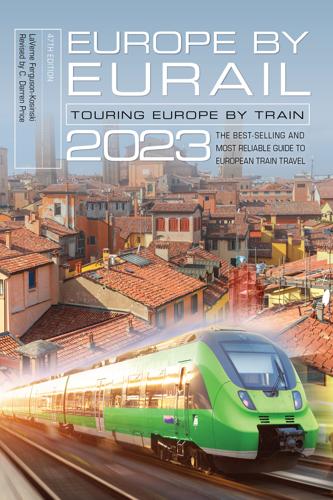
Europe by Eurail 2023
by
Laverne Ferguson-Kosinski
and
C. Darren Price
Published 8 Jan 2023
Lisbon has three distinct districts—the shopping areas clustered around Rossio, Baixa, and Chiado; the more ancient areas, such as the Moorish quarter Alfama and Castelo; and the “new Lisbon,” with post-modern high-rise structures, Amoreiras, stretching out to the airport and to the north. Just five minutes from the airport is the Gare Intermodal de Lisboa multistation complex, also known as Oriental Station, which serves long-distance and suburban trains, the underground railway system, a bus and motor coach terminal, and a taxi stop. A day can easily be spent in any one of Lisbon’s districts. Of particular interest to Western visitors is the Alfama district, which suffered the least damage during the Great Lisbon Earthquake of 1755 and has thereby been able to preserve much of its old facade and narrow, winding cobblestone streets.

The Impact of Early Life Trauma on Health and Disease
by
Lanius, Ruth A.; Vermetten, Eric; Pain, Clare
Published 11 Jan 2011
These findings indicate that the different expressive systems€ – facial expressions, vocalization and gestures€– are not as tightly linked as was previously thought [30]. The less-tight coupling among the different modalities suggests the speculation that infants can make blended configurations or assemblages of expressive gestures in which one modality enhances or diminishes the meaning or intensity of another modality. For example, blended intermodality configurations might convey different messages at the same time€– smiles communicating an intention for social engagement while simultaneous self-touching communicates the intention to disengage. Blended communicative configurations might also convey differences in the intensity of the message (e.g., smiling while self-touching conveys that the infant intends to play, but that the play should be low-key, whereas a smile coupled with a big other-directed gesture conveys the intention to play intensely).

The Rise of the Network Society
by
Manuel Castells
Published 31 Aug 1996
However, in a long personal conversation, after reading the draft of my analysis, he did not disagree with my interpretation of the project of an “architecture of nudity,” although he conceived it rather as an innovative attempt to bring together high-tech and classic design. We both agreed that the new architectural monuments of our epoch are likely to be built as “communication exchangers” (airports, train stations, intermodal transfer areas, telecommunication infrastructures, harbors, and computerized trading centers). 86 For a useful debate on the matter, see Lillyman et al. (1994). 87 Castells (1972: 496ff). 88 For an updated social and spatial, illustrated history of Belleville, see the delightful book by Morier (1994); on urban renewal in Paris in the 1970s, see Godard et al. (1973). 89 Boyer (1994). 90 Jacobs (1993). 91 Machimura (1995: 16).
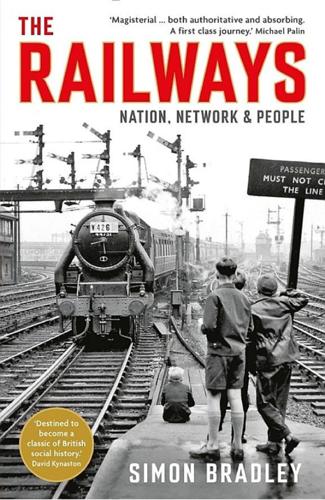
The Railways: Nation, Network and People
by
Simon Bradley
Published 23 Sep 2015
The MGR system was characteristic of the huge power stations built on rural land by the Central Electricity Generating Board in the 1960s and early 1970s, such as Ratcliffe-on-Soar in the Trent Valley, a few miles south of D. H. Lawrence’s truck-haunted native landscape. In place of cheaply built wooden trucks used perhaps once a fortnight, the new hopper wagons could run productively and without a pause for as long as the driver’s shift lasted. Another promising type of traffic was the standard intermodal container, for which BR coined the name Freightliner. Container traffic began to show a profit in 1968, which was also the year in which BR was finally relieved of responsibility for the doomed sundries trade. Containers have since become one of the busiest sectors of the modern rail haulage business, although on a very different basis from the 1960s conception of an alternative to the lorry for inland traffic.

Lonely Planet Washington, Oregon & the Pacific Northwest
by
Lonely Planet
Spokane ArenaCONCERT VENUE (map Google map; %509-279-7000; www.spokanearena.com; 720 W Mallon Ave) Catch major touring bands, comedians and other performers, as well as sporting events, at this 11,000-seat hall opposite the Flour Mill. 7Shopping Auntie’s BookstoreBOOKS (map Google map; www.auntiesbooks.com; 402 W Main Ave; h9am-6pm Mon, to 9pm Tue-Sat, 11am-6pm Sun) A fantastic bookshop with an excellent travel section, regular author readings and book signings, and lots of magazines, games and gifts. 8Information Visitor Information Center (%888-776-5263, 509-744-3341; www.visitspokane.com; 620 W Spokane Falls Blvd; h10am-7pm Jun-Sep, to 6pm rest of year) In Riverfront Park, near the carousel. 8Getting There & Away AIR Spokane International Airport (www.spokaneairports.net) Six airlines serve destinations around the US. BUS Greyhound (www.greyhound.com) buses head off daily to Seattle ($37, six hours, three daily) and Pasco ($37, 2½ hours), departing from the Spokane Intermodal Center (221 W 1st Ave). TRAIN The Amtrak Chicago–Seattle Empire Builder divides in Spokane, with trains heading to Portland via Pasco and Seattle via Wenatchee once a day in either direction. 8Getting Around Spokane Transit (%509-328-7433; www.spokanetransit.com; 701 W Riverside Ave; day pass $4) buses depart from streets bordering the Plaza, a huge indoor transit station at Sprague Ave and Wall St.

Western USA
by
Lonely Planet
Bing Crosby Theater THEATER (WWW.METTHEATER.COM; 901 W SPRAGUE AVE) The former Met, now named after local hero Bing, presents concerts, plays, film festivals and the Spokane Opera in a fairly intimate setting. Information Spokane Area Visitor Information Center (www.visitspokane.com; 201 W Main Ave at Browne St; 8:30am-5pm Mon-Fri, 9am-6pm Sat & Sun) keeps a raft of information. Getting There & Away Buses and trains depart from the Spokane Intermodal Transportation Station (221 W 1st Ave). Amtrak (www.amtrak.com) has a daily service on the esteemed Empire Builder to Seattle ($48, 7½ hours), Portland ($48, 9½ hours) and Chicago ($205, 45 hours). South Cascades The South Cascades are taller but less clustered than their northern counterparts, extending from Snoqualmie Pass east of Seattle down to the mighty Columbia River on the border with Oregon.
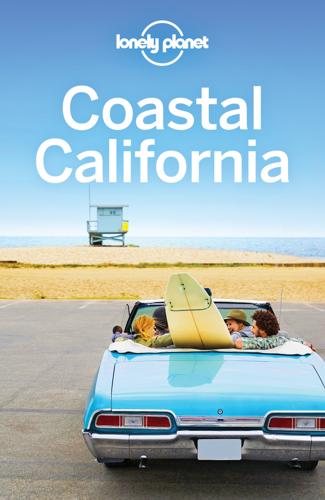
Coastal California Travel Guide
by
Lonely Planet
Visit Anaheim ( GOOGLE MAP ; %855-405-5020; http://visitanaheim.org; 800 W Katella Ave, Anaheim Convention Center) The city's official tourism bureau has information on lodging, dining and transportation, during events at the Convention Center. 8Getting There & Away Disneyland and Anaheim can be reached by car (off the I-5 Fwy) or Amtrak or Metrolink trains at Anaheim's ARTIC (Anaheim Regional Transportation Intermodal Center; GOOGLE MAP ; 2150 E Katella Ave, Anaheim) transit center. From here it's a short taxi, ride share or Anaheim Resort Transportation shuttle to Disneyland proper. The closest airport is Orange County's John Wayne Airport (SNA; GOOGLE MAP ; www.ocair.com; 18601 Airport Way, Santa Ana). Air Most international travelers arrive at Los Angeles International Airport (LAX), but for easy-in, easy-out domestic travel, the manageable John Wayne Airport in Santa Ana is served by all major US airlines and Canada’s WestJet.
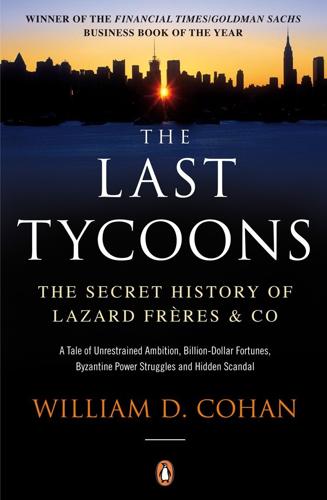
The Last Tycoons: The Secret History of Lazard Frères & Co.
by
William D. Cohan
Published 25 Dec 2015
He quickly figured out "you had to invent what you were going to do." One of his first assignments was to write a white paper on why synergy was good for corporate America, in effect a massive justification for the merger activity that Lazard was facilitating and dominating. A few years later, Andre asked Supino to go help fix a company, Republic Intermodal Corporation, in Lake Success, New York, in which Lazard had an investment. Supino was "seconded" to Republic for two years, turned the company around, and arranged for its successful sale. Before the sale closed, Andre summoned him to the Carlyle. "I went to the Carlyle and up to Andre's suite," Supino recalled.
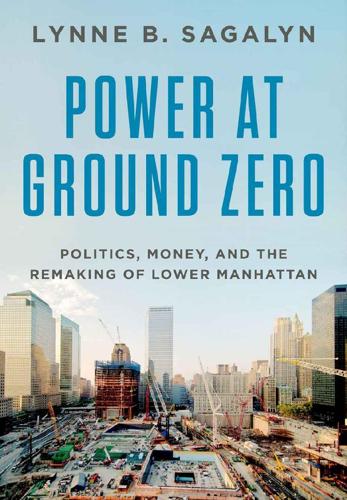
Power at Ground Zero: Politics, Money, and the Remaking of Lower Manhattan
by
Lynne B. Sagalyn
Published 8 Sep 2016
It was a bit figurative to say that the footprints should be kept inviolate down to bedrock, because PATH trains had always run through this area, and Seymour said that the PATH trains were still likely to run along tracks that cross beneath the footprint of the South Tower. The families of the victims were nonetheless incensed at how insensitive the Port Authority was to their concerns. Had they seen the never-released eighty-page final master plan, their ire would have been unfathomable because the PA had placed a “Grand Hall” for the new intermodal transportation and retail center that officials saw as an essential hub for lower Manhattan directly over the complete footprint of the North Tower. Pedestrians would have been diverted around the footprint by a circular colonnade that was part of an interior pedestrian street and public-space system providing access to the retail center and other on-site uses, including a memorial.
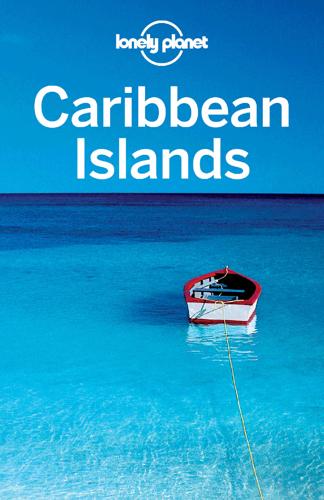
Caribbean Islands
by
Lonely Planet
Running perpendicular at the west end of the town, Calle del Cristo is home to many of the old city’s chicest establishments. Worth looking out for are the jewelry shop and gallery of Bóveda ( Calle del Cristo; 10am-6pm) and Butterfly People ( 257 Cruz; 11am-6pm Sat-Thu) , where you’ll find unusual art incorporating insects. Cigar fans should stop by the open storefront of Cigarros Antillas ( Edif Intermodal Covadonga, opp Pier 3; 9am-5pm) to see workers roll by hand. Information Emergency You may find that telephone directory and tourist publications list nonfunctioning numbers for emergency services. In any kind of emergency, call 911. Medical emergencies ( 754-2550) Tourist zone police ( 911, 726-7020; 24hr) English spoken.

USA Travel Guide
by
Lonely, Planet
Bing Crosby Theater THEATER (www.mettheater.com; 901 W Sprague Ave) The former Met, now named after local hero Bing, presents concerts, plays, film festivals and the Spokane Opera in a fairly intimate setting. Information Spokane Area Visitor Information Center (www.visitspokane.com; 201 W Main Ave at Browne St; 8:30am-5pm Mon-Fri, 9am-6pm Sat & Sun) keeps a raft of information. Getting There & Away Buses and trains depart from the Spokane Intermodal Transportation Station (221 W 1st Ave) . Amtrak (www.amtrak.com) has a daily service on the esteemed Empire Builder to Seattle ($48, 7½ hours), Portland ($48, 9½ hours) and Chicago ($205, 45 hours). South Cascades The South Cascades are taller but less clustered than their northern counterparts, extending from Snoqualmie Pass east of Seattle down to the mighty Columbia River on the border with Oregon.